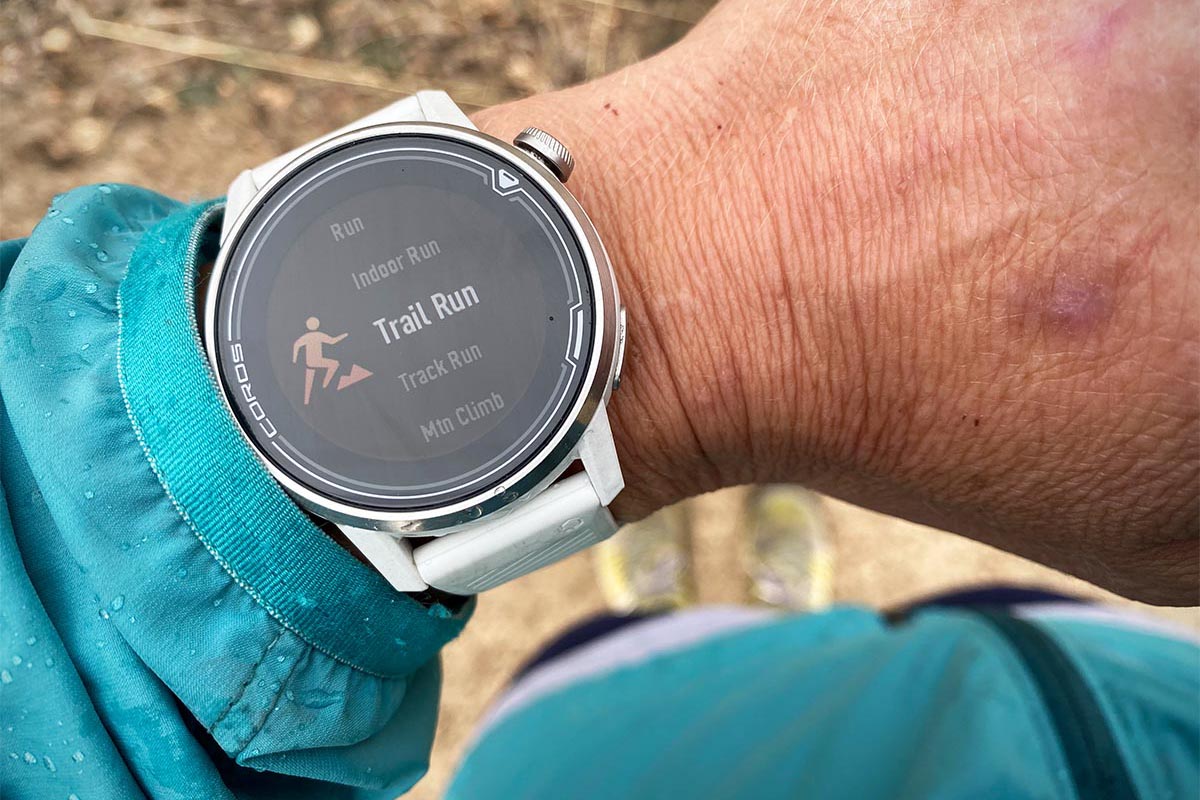
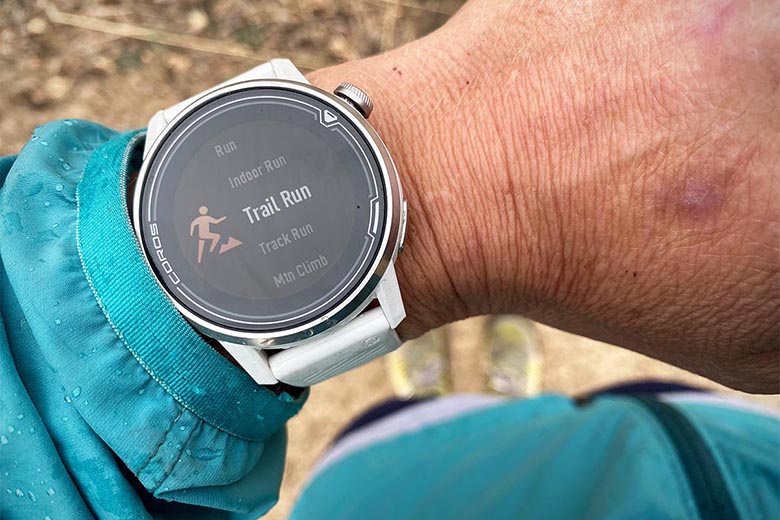
Switchback Travel


Switchback Travel
Despite their diminutive size, fitness watches can really pack a punch. These modern timepieces put the power of a GPS device onto your wrist, allowing you to track your movements, follow a preloaded route, or even navigate complex terrain—hands-free. Importantly, they’re also capable of compiling a seemingly endless amount of data, including your distance, elevation, pace, cadence, heart rate, recovery time, and sleep quality (to name a few). We've put dozens of sports watches to the test over the years, from a 50-mile backpacking trip in Washington's Pasayten Wilderness to countless trail runs near and far. Below we break down our 14 favorites of 2025, including rugged offerings for backcountry explorers, affordable entry-level models, and sleek options purpose-built for endurance athletes. For more background information, see our comparison table, buying advice, and testing process details below the picks. And if you're looking for something robust to bring into the backcountry, we've also compiled a list of the best GPS watches.
Editor’s note: We updated this guide on June 11, 2025, to add the Garmin Fenix 7 Pro Sapphire Solar as our favorite fitness watch for backcountry missions. We also added the Garmin Instinct 3 Solar to the list, ensured all information was up to date at the time of publishing, and included some new photos from recent testing.
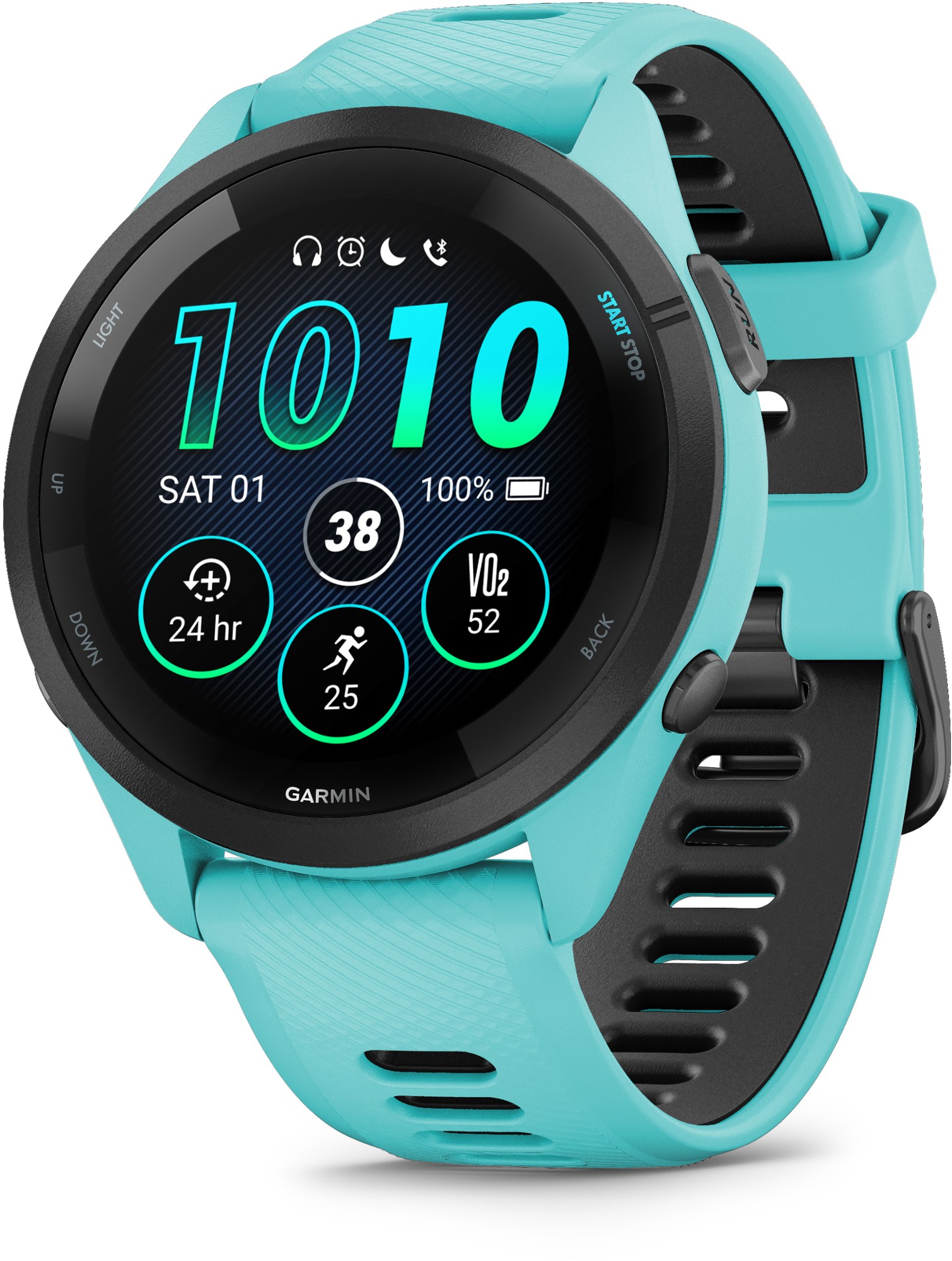 Weight: 1.7 oz.
Weight: 1.7 oz.
Battery: Lithium-ion (13 days in smartwatch mode)
Diameters: 42, 46mm
What we like: Bright screen, sleek looks, and excellent user interface, along with top-notch accuracy and versatility.
What we don't: Lacks the ruggedness necessary for devoted backcountry use; battery life falls short of some competitors (including the past-gen 255).
We get the question all the time: What fitness watch should I buy? In our opinion, the best fitness watch for most folks isn’t the most expensive option, the one with the most features or activity modes, or even the watch that your favorite pro athlete wears. The best fitness watch is the one with features you’ll use—not too few, not too many—in addition to an intuitive user interface, strong battery life, and accurate tracking. With this in mind, the Garmin Forerunner 265 is our top recommendation, with a Goldilocks design that hits a sweet spot for most runners, swimmers, bikers, hikers, Nordic skiers, and more. True to its versatile intentions, the 265 comes in two sizes (42 and 46mm), and a variety of colorways. In this upgrade from their popular and already feature-loaded Forerunner 255, Garmin included music capability (previously a $50 add-on), a bright and detailed AMOLED touch screen, more storage, a slightly upgraded GPS system, and Garmin’s “training readiness” insights for personalized performance.
The sharp and stylish new display does sacrifice a significant 10 hours of battery life in GPS mode compared to its predecessor, the 255. That said, unless you're planning massive days on the trail or running long ultras, you likely don’t need more than 20 continuous hours of GPS. Compared to another popular do-it-all sports watch, the Coros Apex 2 below, the Forerunner has a shorter battery life, lacks the ability to display topographic maps, and has a slightly less durable build, making the Apex the better choice for athletes with serious backcountry intentions. But for all-arounders looking for out-the-door performance, the feature-rich Forerunner takes the prize. It offers Spotify capability and contactless payment, a slightly superior heart rate monitor and GPS system, and the ability to track metrics from menstrual cycles to stress to shoe mileage. Note: At the time of publishing, you can save some serious cash by opting for the prior-generation Forerunner 255, which offers similar performance but with fewer built-in features.
See the Garmin Forerunner 265
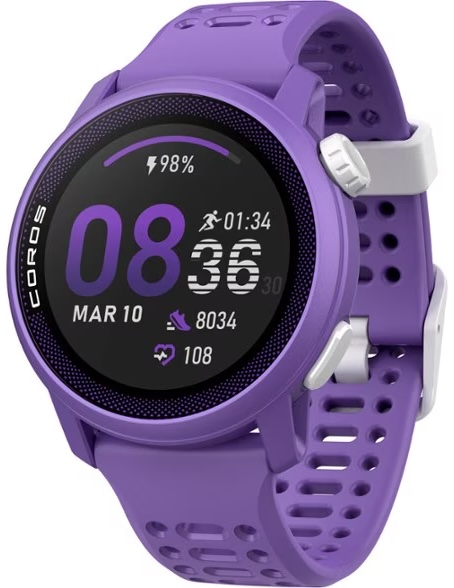 Weight: 1.1 oz.
Weight: 1.1 oz.
Battery: Lithium-ion (15 days w/ daily and sleep tracking)
Diameter: 41.9mm
What we like: A sleek multisport watch with great battery life for just over $200.
What we don’t: No-frills feature set and not intended for backcountry use.
Despite its diminutive size, it's hard to overlook the budget-friendly Coros Pace 3. This watch has a lot going for the price: It clocks in at just 1.1 ounces (with the nylon strap) and has such a low profile that we often forget we’re wearing it, which is a nice change of pace from a bulky and heavy model like the Fenix 7 Pro below. Battery life is also impressive (38 hours in GPS mode and 15 days with regular use), and you'd be hard-pressed to find a more affordable watch with a built-in barometric altimeter and multi-GNSS support. Finally, you can now upload tracks to the Pace and follow them via breadcrumb navigation—a truly unheard-of feature at this price point. All told, for budget shoppers or athletes who don’t need the best of the best, the Pace 3 delivers in spades.
Still, it’s important to recognize the Pace 3’s limitations. Most significantly, Coros very intentionally designed this model for frontcountry activities like road running, biking, and pool swimming—though the latest 3 does add the ability to track skiing and snowboarding, along with music capability and dual-frequency GPS for better tracking. And its construction follows suit: The plastic build won’t hold up to major impacts (nor is it a very stylish option for everyday wear), and the small digital dial is difficult to use with gloves on. Water resistance is also average at just 5 ATM (meaning it can endure 50 meters of underwater pressure). But we’ve found the Pace’s GPS tracking, mileage, and elevation to be fairly consistent with high-end Garmin watches, which is flat-out impressive given the price. But if you’re willing to spend up, Coros’s latest Pace Pro ($349) more than doubles the Pace 3’s battery life when using GPS (31 hours) and offers landscape and topo maps, as opposed to the Pace 3’s simpler breadcrumb navigation.
Read more: Coros Pace 3 review
See the Coros Pace 3
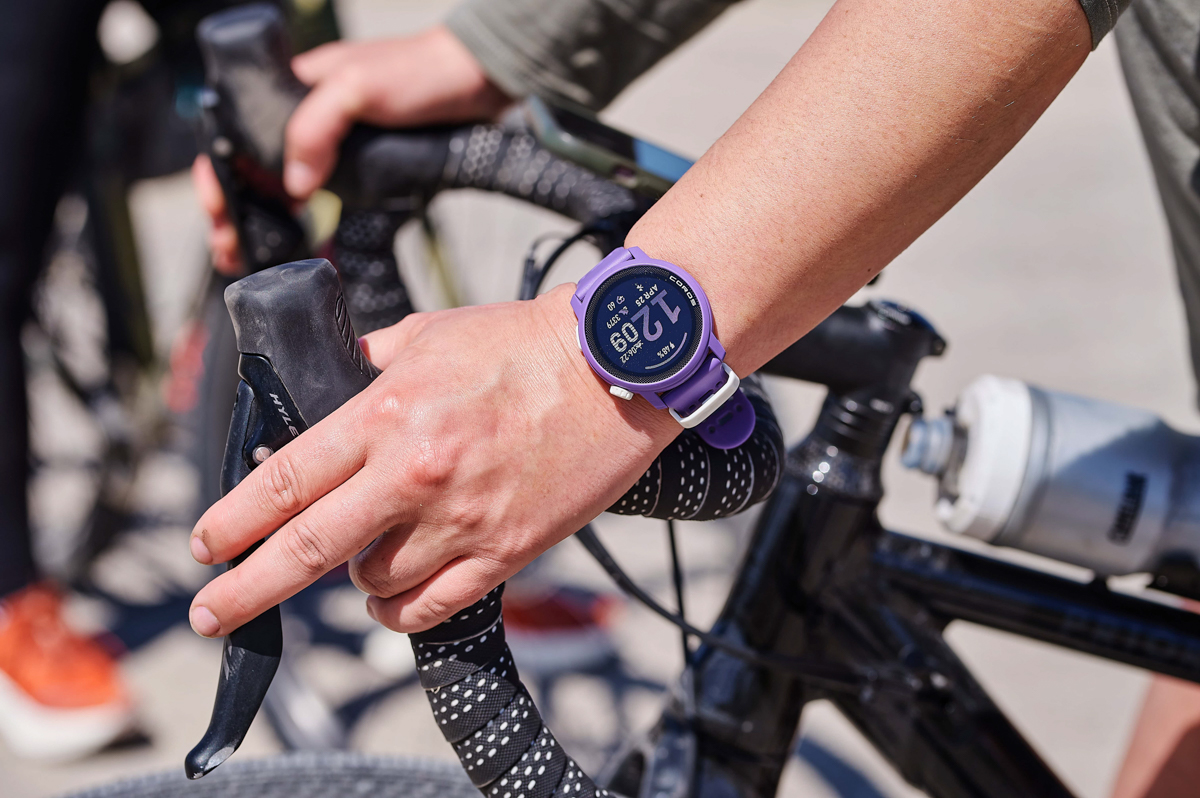
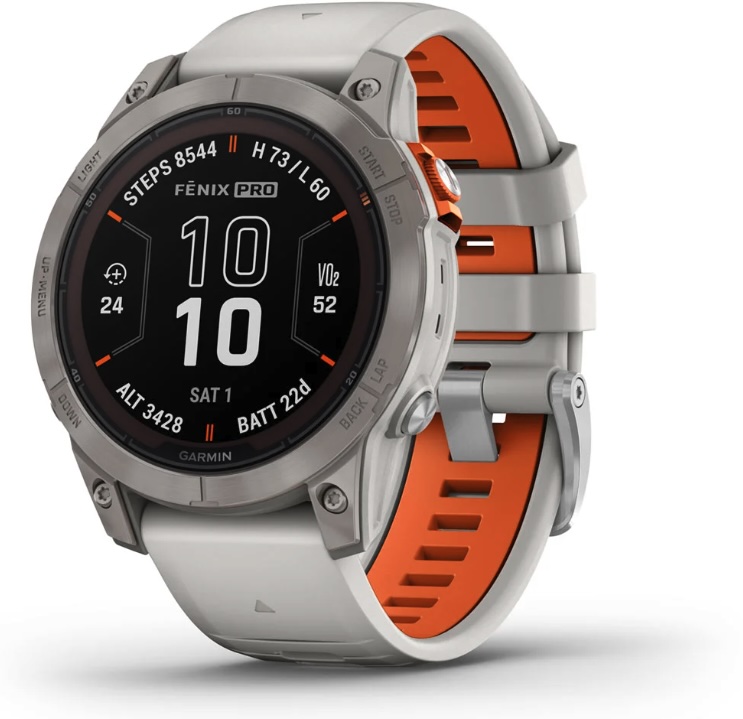 Weight: 2.8 oz.
Weight: 2.8 oz.
Battery: Lithium-ion and solar (18 days in smartwatch mode; 22 days w/solar)
Diameters: 42, 47, 51mm
What we like: Durable construction with the best in mapping, navigation, and solar charging.
What we don’t: Expensive, heavy, and overkill for casual users; only the Sapphire Solar version is available at the time of publishing.
Garmin’s Fenix 7 Pro is undoubtedly expensive, but the Fenix series is hands-down the best backcountry-ready fitness watch collection on the market. This powerhouse line boasts top-notch build quality and durability, a crisp and easy-to-read screen, accurate tracking for a wide array of activities, and enough advanced metrics to satisfy even the most discerning athletes. Importantly, the Fenix 7 Pro also offers the best available watch-based mapping: You get preloaded maps (including detailed contour lines, trails, and geographic place names) and extensive navigation tools for activities ranging from hiking and mountaineering to trail running and skiing. And if you’re planning on spending more than a few days in the backcountry, the Fenix 7 Pro’s solar charging is a serious win for battery life.
The biggest downsides of the Fenix 7 Pro are cost, complexity, and weight. At the time of publishing, Garmin is only offering the Sapphire Solar version, which runs a pricey $900 for the 42 and 47-millimeter sizes ($1,000 for the 51mm). Moreover, the tech is overkill for someone just looking for the basics like distance covered, elevation gain, and heart rate. And even in the smallest form, the Fenix is on the heavy side—you will feel the extra heft during activities like running and mountain biking. Coros’s Apex 2 and Garmin’s Instinct 3 below are cheaper and simpler alternatives to the Fenix, so long as you’re willing to sacrifice a bit of battery life (the Instinct 3 does solar charging, though) and mapping technology. Lastly, it’s worth noting that Garmin recently released the Fenix 8 Pro, which has a longer battery life (21 days in smartwatch mode), an AMOLED display, and an upgraded interface. That said, early reviews have reported a buggy user experience, and the $1,100 price tag makes us hesitate to recommend it over the 7 Pro.
Read more: Garmin Fenix 7 Pro Sapphire Solar review
See the Garmin Fenix 7 Pro Sapphire Solar

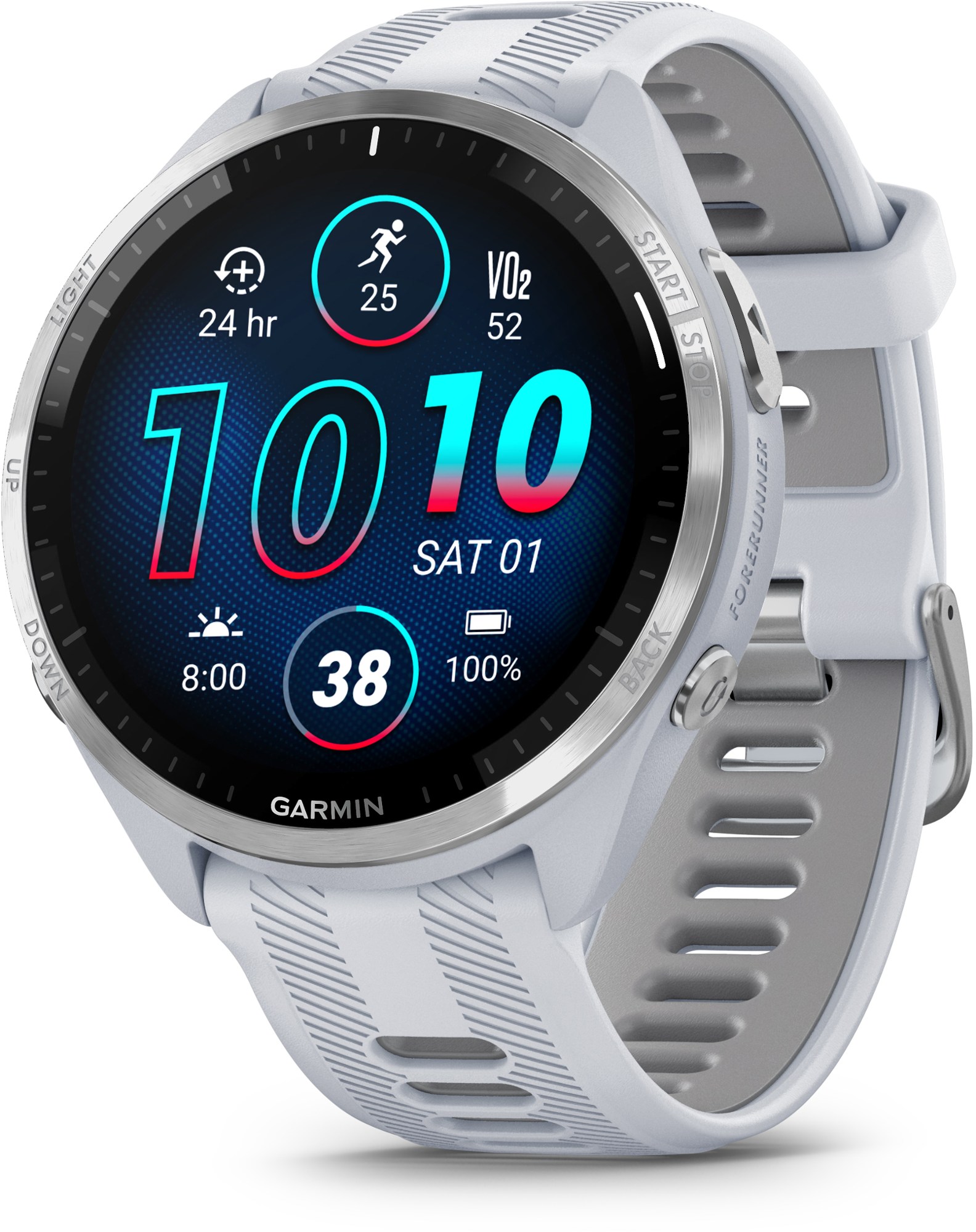 Weight: 1.9 oz.
Weight: 1.9 oz.
Battery: Lithium-ion (23 days in smartwatch mode)
Diameter: 47.2mm
What we like: High-end sensors and crystal-clear screen in a lightweight, sport-specific build.
What we don’t: Only comes in one size; less durable than the Fenix.
Garmin’s Fenix 7 Pro is hard to beat for backcountry exploration, but the Forerunner 965 is a top-notch fitness watch for serious and data-hungry athletes who like to stick a little closer to home. You get a very similar feature set, including multi-band GNSS support, a barometric altimeter and compass, an optical heart rate monitor and pulse oximeter, music storage, and great navigation with preloaded topographic, road, and trail maps. But what stands out about the Forerunner is its size: While the 2.8-ounce Fenix 7 can feel overly bulky for activities like running and swimming, the sleek 965 clocks in at only 1.9 ounces. It all adds up to a premium watch that’s purpose-built for triathletes, runners, cyclists, and others focused on traveling fast and light.
The Forerunner 965 gets our glowing recommendation for frontcountry use, but it’s certainly not as versatile as the Fenix 7 Pro. Durability falls short with less rugged materials (Garmin uses a glass lens rather than the Fenix’s sapphire) and a lower water rating (5 ATM vs. 10)—we’ve used our prior-generation Forerunner 955 a lot in the mountains, and it’s riddled with scratches. Another downside is battery life: While we appreciate the addition of a bright and big AMOLED screen, the trade-off is a significant 11 hours less battery life in GPS mode compared to its predecessor (which used a slightly smaller and lower-resolution screen). Still, 31 hours in GPS mode and 23 days in smartwatch mode is ample for most folks, and the Forerunner is one of the most featured sports watches for activity-specific tracking (with considerably more capabilities than the value-oriented Apex 2). Finally, if you don’t need the AMOLED screen, the previous-generation Forerunner 955 is available at a sizable discount while supplies last.
See the Garmin Forerunner 965
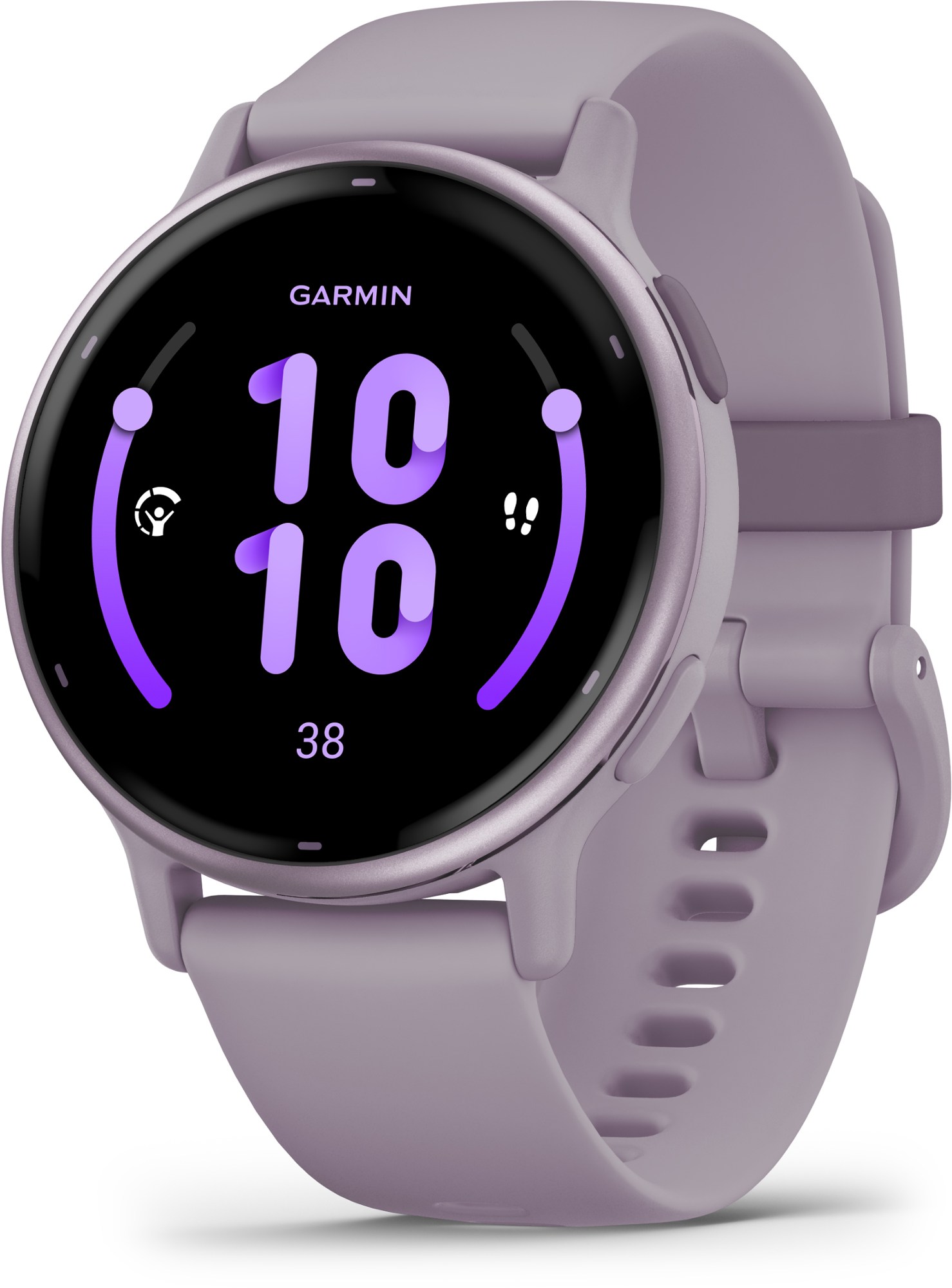 Weight: 1.3 oz.
Weight: 1.3 oz.
Battery: Lithium-ion (11 days in smartwatch mode)
Diameters: 42.2mm
What we like: Great styling and feature set for everyday use.
What we don’t: Basic feature set and touchscreen limit it to the frontcountry.
Fitness watches are designed to look good during a workout, but they can often appear too sporty for the office or around town. Most users will find that models like the Garmin Fenix 7 above and Instinct 2 below are simply too bulky for everyday use, and sleek options from Coros are fairly limited when it comes to convenient extras like contactless pay, music, and health monitoring. The Garmin vívoactive 5 strikes an excellent middle ground, with an elegant exterior and very capable feature set, including multi-GNSS support, a compass and barometric altimeter, tons of sport modes (including meditation, pool swimming, yoga, and skiing), and Garmin’s most sought-after smart features.
While we had some concerns with the software on the prior-generation vívoactive 4 (its accuracy faltered while tracking steeper trail runs), the 5 has so far proved accurate. We’ve been using ours routinely for evening runs and mellow hikes, but we also like how easily it can crossover into casual use—unlike the more sporty-looking options here, the vívoactive 5 is classy and low profile, and it doesn’t make too much of a statement. That said, its simple feature set limits it to frontcountry use: It doesn’t have maps, and its navigation function is relatively basic. We also don’t usually opt for touchscreen watches for dedicated backcountry use, as they don’t play nice with gloves or in rainy weather. Garmin has since come out with the vívoactive 6, which has a slightly upgraded user interface and tracking technology, though most features and software remain the same between the two models. For $30 less, we’ll stick with the 5 for now. In the same category, it’s also worth checking out Garmin’s Venu 3 ($450), which features additional music storage and activity profiles, along with a more modern interface.
See the Garmin vívoactive 5
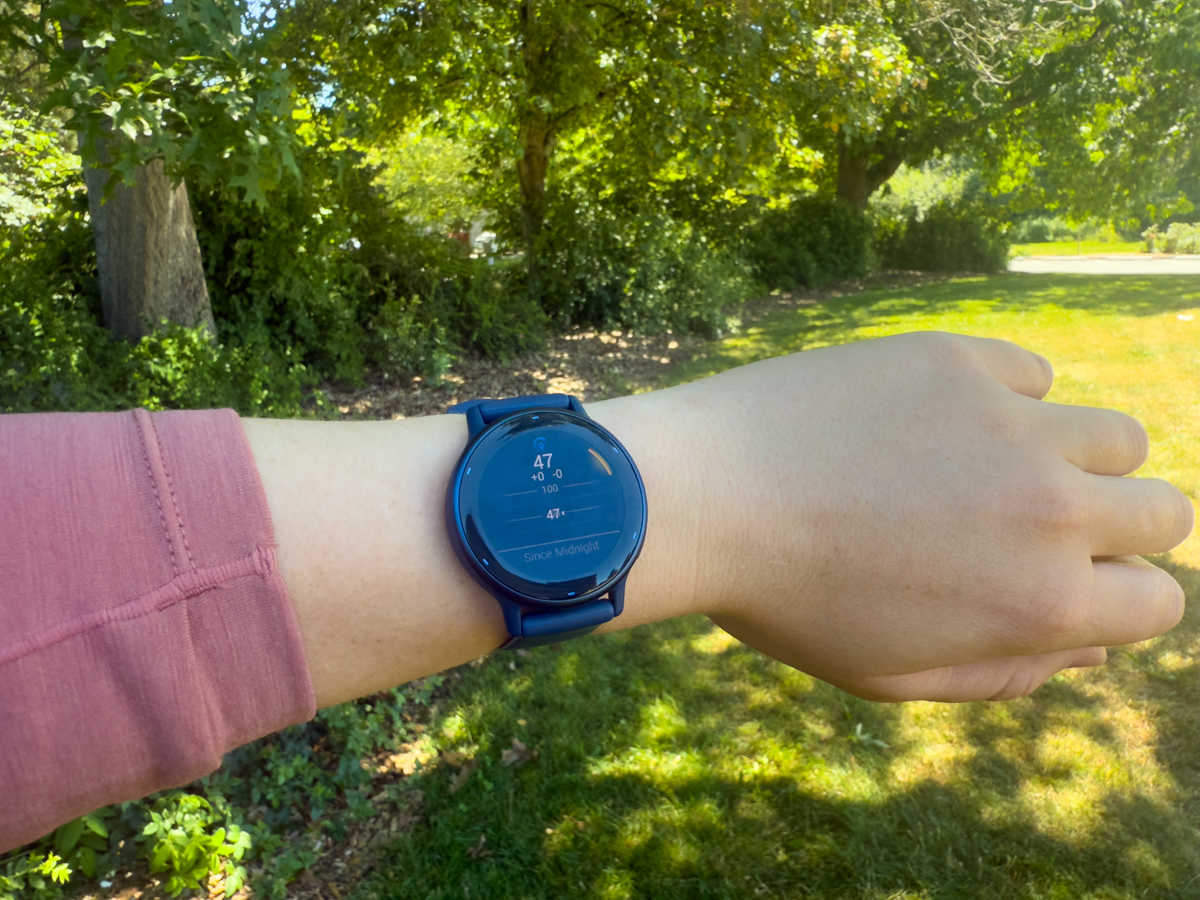
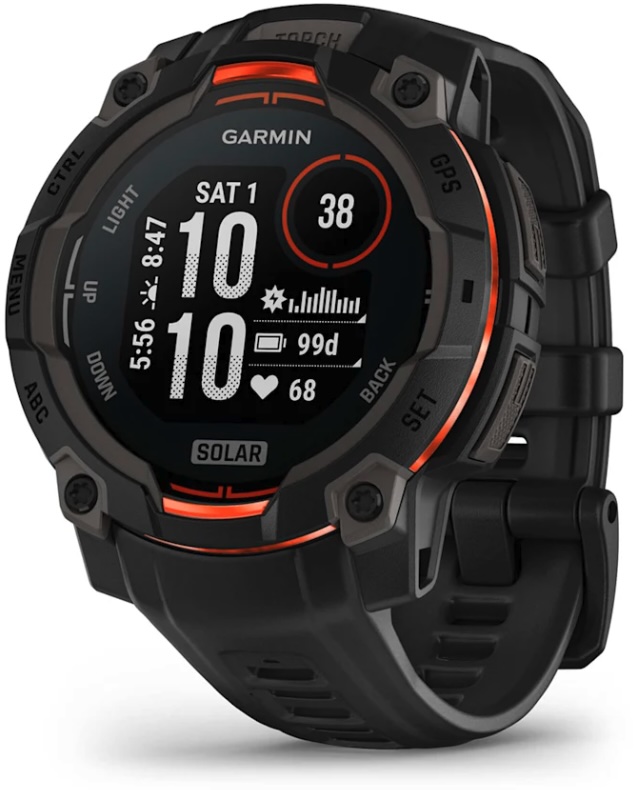 Weight: 2.8 oz.
Weight: 2.8 oz.
Battery: Lithium-ion and solar (28 days in smartwatch mode; unlimited w/ solar)
Diameters: 40, 45, 50mm
What we like: Modern features combined with a rugged build and long battery life.
What we don’t: The Fenix 7 Pro has it beat in terms of battery life and navigation.
With a rugged aesthetic and barebones black-and-white display, the Instinct Solar has long been considered Garmin’s function-first watch for the outdoor and tactical crowd. However, the few of updates have given the series a new lease on life, incorporating modern features that bring it in line with the other watches on this list. The main talking point is still the inclusion of solar charging: In sunny conditions, the Instinct 3 Solar runs for up to 40 hours in GPS mode (60 in the largest 50mm version) and has virtually unlimited power in smartwatch or expedition GPS modes—assuming it sees three hours of sun a day. The 3 also features a few other modest upgrades, including a more premium display, a multi-band GPS chipset, and a basic maps feature that displays city names and grid lines (the Instinct 2 was limited to a simple navigation function). For just $400 for the 40- and 45-millimeter versions ($450 for the 50mm), the Instinct 3 offers a lot of bang for your buck.
However, the Instinct 3 is not Garmin’s most premium or featured offering by any means—the Forerunner 965’s sleek build and music storage makes it a slightly better multisport option, while the Fenix 7 Pro offers full mapping capabilities and even longer battery life (57 hours in GPS mode) for serious backcountry enthusiasts. But the combination of still-excellent battery life, low price, and barebones functionality is hard to beat—the Instinct series has consistently topped our GPS watch round-up for this reason. Finally, the Instinct 3 version comes in 40, 45, and 50-millimeter sizes and a variety of different colorways, making the watch accessible to a large audience. But if you don’t need the most souped-up version, the Instinct 2 is still available for a significant discount on Garmin’s site at the time of publishing.
See the Garmin Instinct 3 Solar
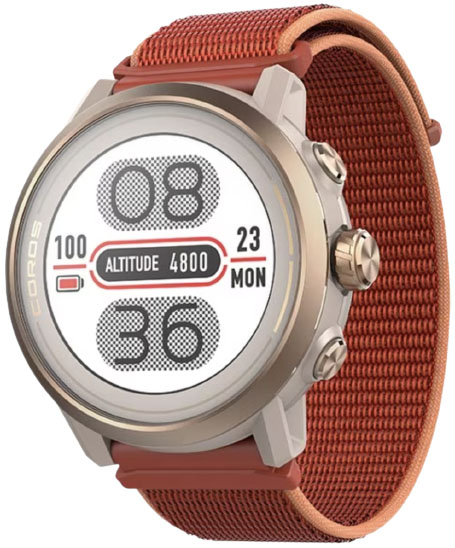 Weight: 1.5 oz.
Weight: 1.5 oz.
Battery: Lithium-ion (14 days w/ daily and sleep tracking)
Diameter: 43mm
What we like: Ridiculously good battery life, premium materials, and on-screen topographic maps at a great price.
What we don’t: Not a great fit for cyclists; lacks some of Garmin’s modern touches.
In just a few years, Coros has gone from unknown entity to household name in the fitness watch world. The Apex 2 is their leading mid-range model and packs in a surprising amount of features for the price, including touchscreen navigation, a titanium alloy bezel and sapphire glass screen, multi-GNSS support, eight different sensors (including a pulse oximeter), and music storage. The interface has a clear prioritization of sport-specific tracking (you get over 25 modes ranging from XC skiing to triathlon) that pairs seamlessly with a smartphone app, and the color display is easy to navigate with just two buttons and one dial. Most notably, battery life is best-in-class—the Apex 2 outlasts Garmin’s Forerunner 965 by about 9 hours in GPS mode. And although the watch only comes in one size, it hits a sweet spot at 43 millimeters and has been a great fit for both our male and female testers.
When friends ask us what fitness watch to buy, we generally waver between recommending the Apex 2 and Forerunner 265 above. The Forerunner wins out for most, but the Coros is the better watch for adventure-minded folks who will appreciate its longer battery life, topographic maps, glove-friendly operation, and more durable—and premium—materials. Keep in mind that the Apex doesn't include modern frills like live tracking, contactless payment, or music streaming, and it's definitely not the best choice for cyclists—it's not compatible with ANT+ sensors and lacks a mountain bike activity mode. And we just can't get behind the Velcro watch band, which proudly reads #exploreperfection (you can purchase a silicone band for an extra $29). But if you need a long-lasting and durable watch for your mountain escapades, the Apex 2 is a very worthy option and a full $550 less than the Fenix 7 Pro above. For a step up, Coros also offers the Apex 2 Pro ($449), which includes a larger display, longer battery life, and dual-frequency GPS for better location accuracy.
See the Coros Apex 2
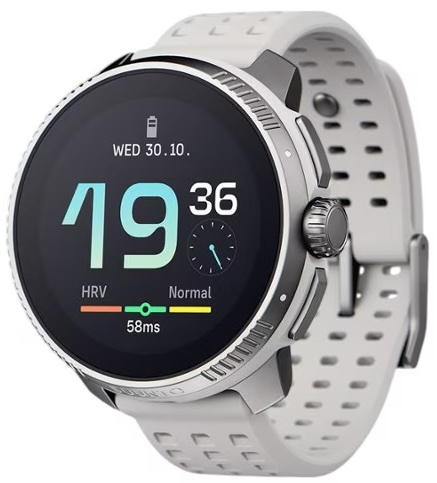 Weight: 2.9 oz.
Weight: 2.9 oz.
Battery: Lithium-ion (26 days in time mode)
Diameter: 49mm
What we like: Beautiful display, sleek design, and competitive battery life for considerably less than comparable Garmins.
What we don’t: Subpar mapping ability compared to Garmin's high-end Fenix 7 Pro.
Suunto has a reputation for reliable products and accurate tracking, but their watches have fallen short of late in terms of modern touches like smart features and convenient app support. The Race, however, is an exception. For comparison, the Race costs around the same as Garmin’s Forerunner 265 but is more in line with the $600 Forerunner 965 above. With the Race, you get a similarly bright and vivid AMOLED screen, detailed mapping, dual-band GNSS, music capability, and over 95 sport modes—along with twice the battery life of the 265 (and three days more than the 965) in time mode. Both Garmins boast smaller screens, have more refined interfaces, and are lighter by around an ounce, which makes them better for around-town use, but ultrarunners and those inclined towards long backcountry adventures will find a lot to like with the Race.
Another compelling option from Suunto is their Vertical ($499), which (as its name suggests) is purpose-built for climbers and mountain adventurers. We tested the high-end Vertical Titanium Solar ($699), which offers a wildly long-lasting 85 hours of battery life in multi-band GNSS mode. It lacks the bright and highly contrasted AMOLED screen of the Race—and is out of reach price-wise for many—but is better-suited for multi-day expeditions and backcountry missions (see our in-depth review here). And like the Race, the Vertical’s mapping functionality falls short of higher-end Garmin designs like the Fenix 7 Pro (which also has a more refined feature set), but not everyone needs all the bells and whistles of a Garmin. In any case, we think the Race and Vertical are both great additions to the market with classy looks (which cross over nicely for around-town use), impressive battery life, and an easy-to-use interface.
See the Suunto Race
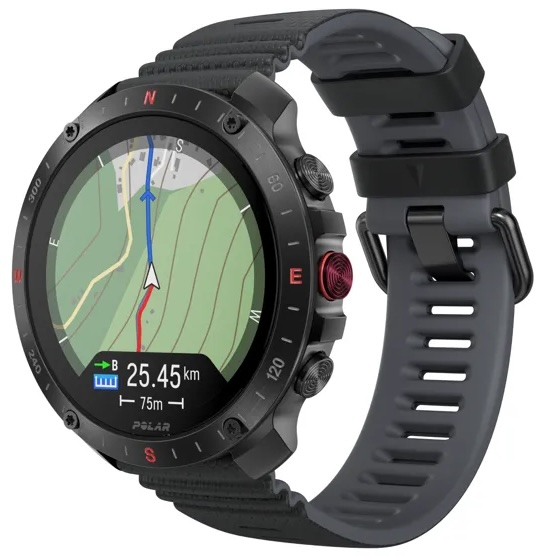 Weight: 2.8 oz.
Weight: 2.8 oz.
Battery: Lithium-ion (10 days in smartwatch mode)
Diameter: 48.6mm
What we like: Durable build with some tasteful updates from the prior-generation Grit X.
What we don’t: Expensive; lacks the accuracy and premium features of Garmin offerings.
Polar might not be a household name like Garmin or Suunto, but their sports watches hold their own in a competitive market. The Grit X2 Pro here is their most premium multisport offering, designed as a rugged alternative to their sleeker Vantage V3 and a competitor to high-end designs like Garmin’s Fenix 7 above. With a stainless steel bezel, sapphire glass touchscreen, and robust and weather-ready build, the Grit X2 Pro is a decidedly hardwearing timepiece, and you get great tracking with multi-GNSS support and a plethora of multisport settings. The latest X2 Pro also offers several upgrades over the discontinued Grit X, including better resolution, improved durability, ECG and SpO2 sensors, and longer battery life in all modes.
Despite all its strengths, the Polar Grit X2 Pro has one glaring downside: its price tag. In fact, at $750, the Grit is the second-priciest model on our list—right behind the $900 Garmin Fenix 7 Pro above. And we hesitate to say the cost is worth it: The Grix X2 Pro’s heart rate monitor isn’t the most accurate, and the watch isn’t compatible with ANT+ sensors (it supports Bluetooth accessories only, which is a downside for indoor cyclists and those who want the ability to connect to multiple sensors or devices at once). Finally, while we appreciate the ability to control music during a workout, we wish storage were included for the price. If you’re not tied to the rugged build and outdoor-specific feature set, Polar’s Vantage V3 is sleeker, lighter (2.0 oz.), and more everyday-friendly with identical software for over $200 less. A final option to consider is their Grit X Pro, which is technically the replacement for the outgoing Grit X but falls short of the X2 Pro in resolution, durability, and battery life.
See the Polar Grit X2 Pro
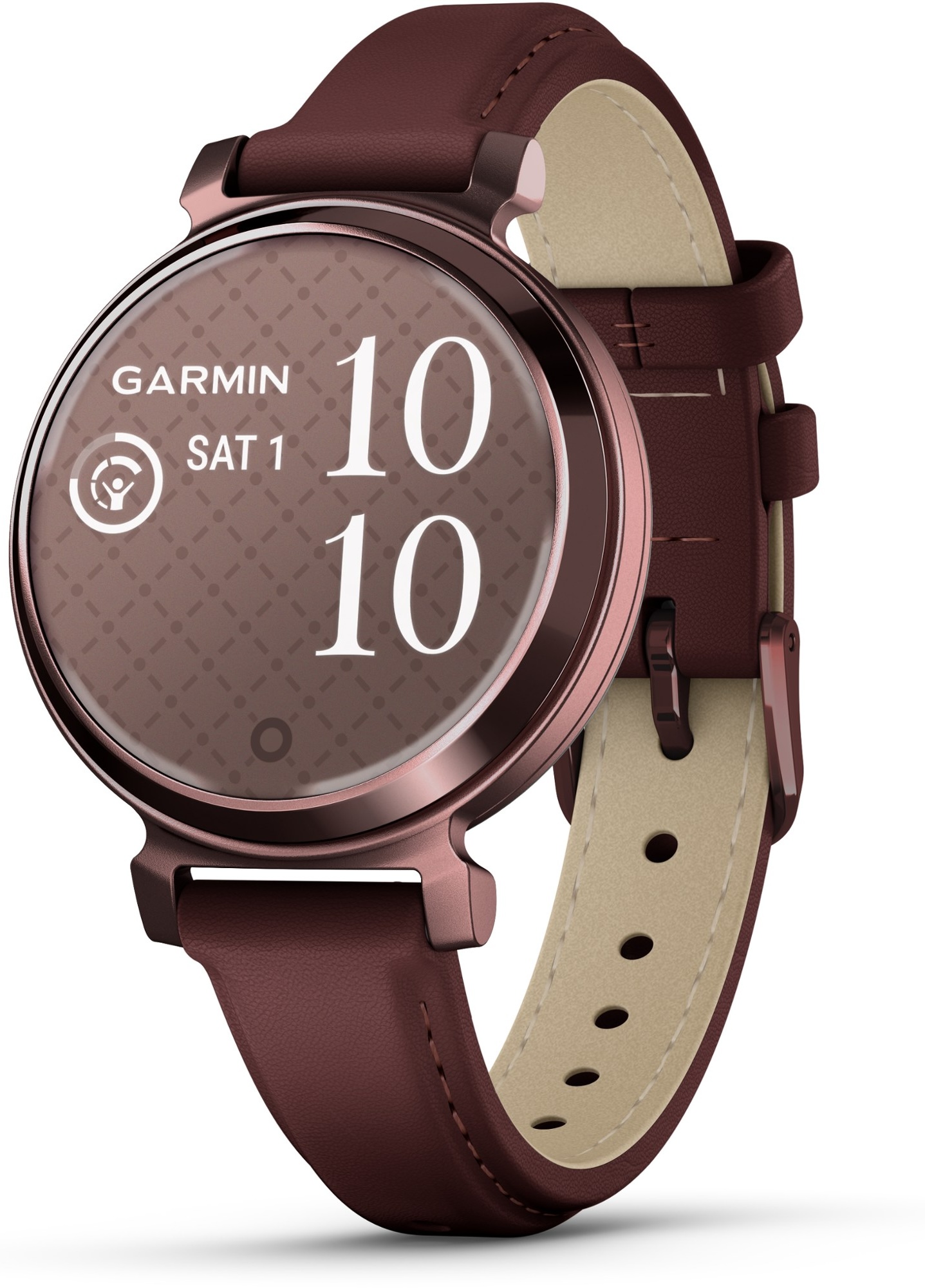 Weight: 0.9 oz.
Weight: 0.9 oz.
Battery: Lithium-ion (5 days in smartwatch mode)
Diameter: 35.4mm
What we like: A truly stylish, light, and affordable women’s-specific design.
What we don’t: Some will find its simplicity limiting.
Garmin’s vívoactive 5 above is our favorite everyday-friendly fitness watch, but we’d be remiss not to mention their equally stylish, women’s-specific Lily 2 here. For $20 less than the vívoactive, Lily 2 offers adequate fitness and daily tracking for casual users and tacks on a unique dance profile that records data during Zumba, hip-hop, and other similar workouts. It also offers detailed menstrual cycle tracking through the Garmin app, including the ability to log daily symptoms, view long-term patterns and fluctuations, and predict your next cycle. And we can’t help but love the streamlined and eye-catching design, with a buttonless face, thin band, and small but very readable display. Last but not least, the Lily 2 is a practical daily companion with the ability to receive calls and texts, control music via your phone, and check the weather forecast. And if you’re willing to spend $30 more (or $50 for the leather wristband), the Lily 2 Classic features Garmin’s contactless payment.
The Lily 2 is about as simple as it gets in the sports watch world and lacks the backcountry appeal of many pricier competitors. Its aluminum case can’t hold a candle to the burlier titanium bezel you get with Garmin’s Forerunner 965 above (though the Lily's Gorilla Glass screen is very high-quality). It’s also the only design here that lacks built-in GPS, requiring connection to a smartphone in order to track activities like runs, bike rides, and walks. And we’re underwhelmed by its five-day battery life, which is one of the shortest on our list. But for women looking for a basic fitness watch that wears well at the office and around town, the Lily 2 could be everything you need and nothing you don’t.
See the Garmin Lily 2
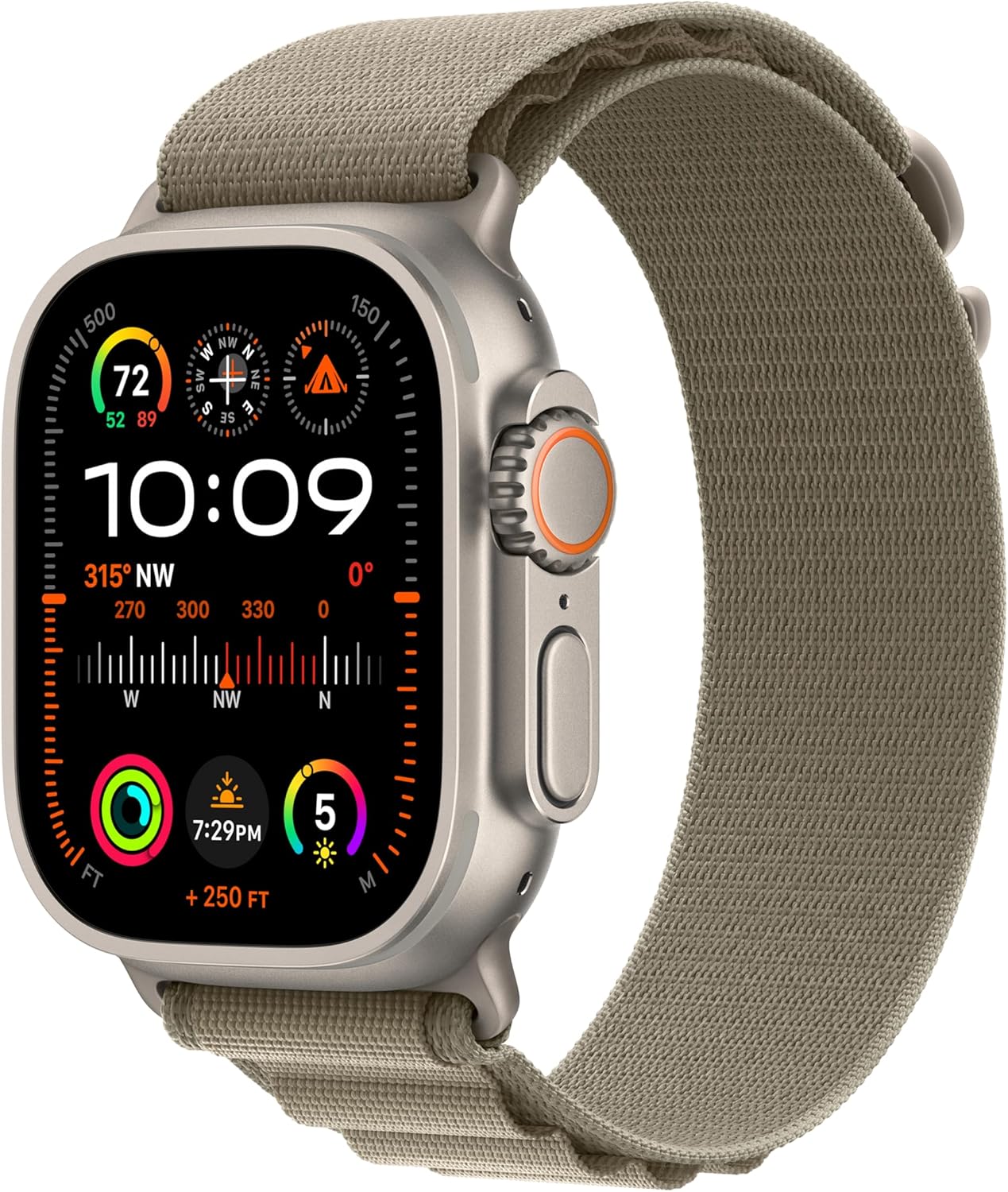 Weight: 2.2 oz.
Weight: 2.2 oz.
Battery: Lithium-ion (36 hours of normal use; 72 hours in low-power mode)
Diameter: 49mm
What we like: A serious fitness watch with the added bonus of Apple’s seamless UI and app support.
What we don’t: Not as fine-tuned for backcountry adventure as other options on this list.
For years, the Apple Watch sat on the fringes of the sports watch world, offering just enough features to appease Apple devotees but never enough to warrant attention from the wider fitness community. But with the release of the Apple Watch Ultra, they made a solid entry onto the scene with a GPS-equipped fitness watch that can hold court with premium designs from Garmin, Coros, and Suunto. Their Ultra 2 is an even stronger addition to the market: The latest model boasts twice the storage, a brighter screen, an upgraded “neural engine” for ease of use, and more activity modes to choose from. Battery life is also up to speed for most people’s needs—Apple claims the Ultra will last for the length of an average Ironman—and updated activity profiles display all the advanced metrics an athlete might desire. Rounding out its outdoor focus, the Ultra features a unique emergency siren for help in search-and-rescue scenarios. Tack on essentials like reliable multi-GNSS support, a barometric altimeter, and a depth gauge down to 40 meters, and Apple’s newest watch is definitely worthy of attention.
We’re big fans of the Apple Watch Ultra 2 for athletes who log most of their miles in the frontcountry, and its user interface and health-tracking platforms are a cut above the rest. But the Ultra 2 still falls short for backcountry use: While a new software update did unveil compatibility with at least some topographic maps, the watch isn’t as proficient a navigator as other options on this list. It also relies heavily on the touchscreen, which will be a big hangup for those who regularly get out in wet or cold conditions (although the new S9 chip enables voice commands). But all in all, for a daily training tool with a class-leading user experience, it doesn’t get much better. For non-Apple users, Samsung offers the comparable Galaxy Watch Ultra with similar software and features and a longer claimed battery life for around $150 less.
See the Apple Watch Ultra 2
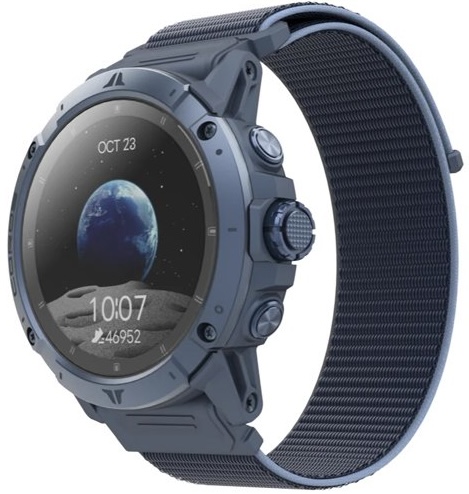 Weight: 2.5 oz.
Weight: 2.5 oz.
Battery: Lithium-ion (36 days w/ daily and sleep tracking)
Diameter: 50.3mm
What we like: Great at altitude and in extreme temperatures; improved GPS accuracy and heart rate sensor compared to the previous model.
What we don’t: Falls short of the Garmin Fenix 7 Pro.
With a steep price tag and rugged, mountain-ready build, it doesn’t take more than a quick glance to see that the Coros Vertix 2S goes head-to-head with our top-ranked Garmin Fenix 7 Pro. This is Coros’ premium offering, equipped with all the sensors we look for in a high-end watch (including a barometric altimeter and pulse oximeter), a battery life of 40 days in smartwatch mode and 118 hours in GPS mode (the Garmin’s are 18 days and 57 hours, respectively), and great performance in extreme temperatures and at altitude—including SpO2 alerts that help you monitor your blood oxygen levels. To add to its already-impressive durability, the Vertix 2S comes in a Pelican-style hard case, and the rest of the design follows suit with a sapphire glass screen and a titanium bezel and cover. Coros even added a touchscreen, which is especially helpful when using mapping and navigation features. Plus, the large dials are a breeze to operate with gloves on.
The Vertix 2S is the latest upgrade in the series, with the most notable benefits being a better heart rate sensor and improved GPS accuracy. However, we’re disappointed that the Vertix no longer comes in a Pelican-style hard case—the packaging box can be reused for storage, but the waterproof case was certainly a nice touch. What’s more, Coros doesn’t include location names on their maps, although you do get turn-by-turn navigation, which the outgoing Vertix 2 didn’t offer. Finally, the Vertix 2S doesn’t offer Spotify, Apple, or Pandora support, making the music feature a bit clunky, nor does it have ANT+ compatibility (it supports Bluetooth accessories only). While we think the Fenix Pro is a better all-around design, you can save a significant $200 by opting for the Coros instead, making it a great choice for Coros devotees looking for a rugged watch to take into extreme environments.
See the Coros Vertix 2S
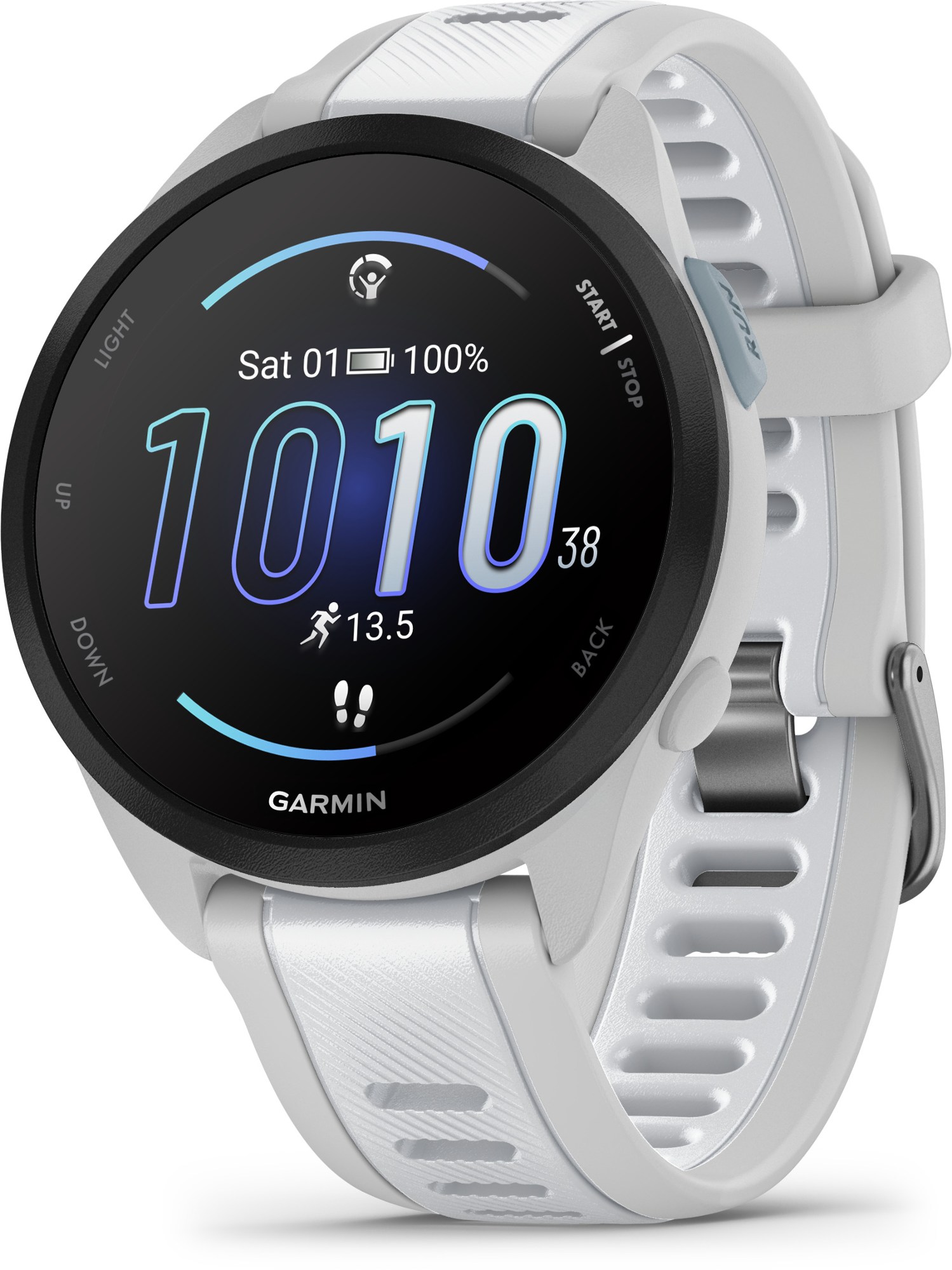 Weight: 1.4 oz.
Weight: 1.4 oz.
Battery: Lithium-ion (11 days in smartwatch mode)
Diameter: 43mm
What we like: A simple watch with a beautiful display and all the benefits of the Garmin ecosystem.
What we don’t: The Coros Pace 3 above has better battery life for around $20 less.
We could wax poetic about anaerobic thresholds, wrist-based fitness coaches, and unlimited battery life, but let’s face it: Most of us use our watches to track daily workouts and not much else. If you’re new to fitness tracking or aren’t necessarily tech-savvy, you can save a lot of money by opting for a simplified design, and the good news is that these models are easier to use, too. Along with the Coros Pace 3 above, Garmin’s Forerunner 165 is one of our favorite basic sports watches, with an eye-catching aesthetic, bluetooth connectivity that makes it easy to upload your workouts and get firmware updates, and access to Garmin’s top-notch ecosystem. And the 165 tacks a variety of features onto the older 55—most notably a compass, barometric altimeter, and bright and beautiful AMOLED screen.
The Forerunner 165 is a close competitor to the aforementioned Pace 3 but falls short in a couple key areas, including battery life (a substantial 19 hours less in GPS mode) and price (the Coros is around $20 cheaper). Despite these shortcomings, the Forerunner still has a lot going for it, particularly for those who value a sleek user interface, want top-notch app support and health monitoring (the Garmin has a better HR monitor and offers more accurate sleep tracking), and plan to stick to the lowlands. Finally, as we mentioned above, the higher-end (but lower-resolution) Forerunner 255 is available for $350 at the time of publishing, and the previous iteration—the Forerunner 55—will save you $50.
See the Garmin Forerunner 165
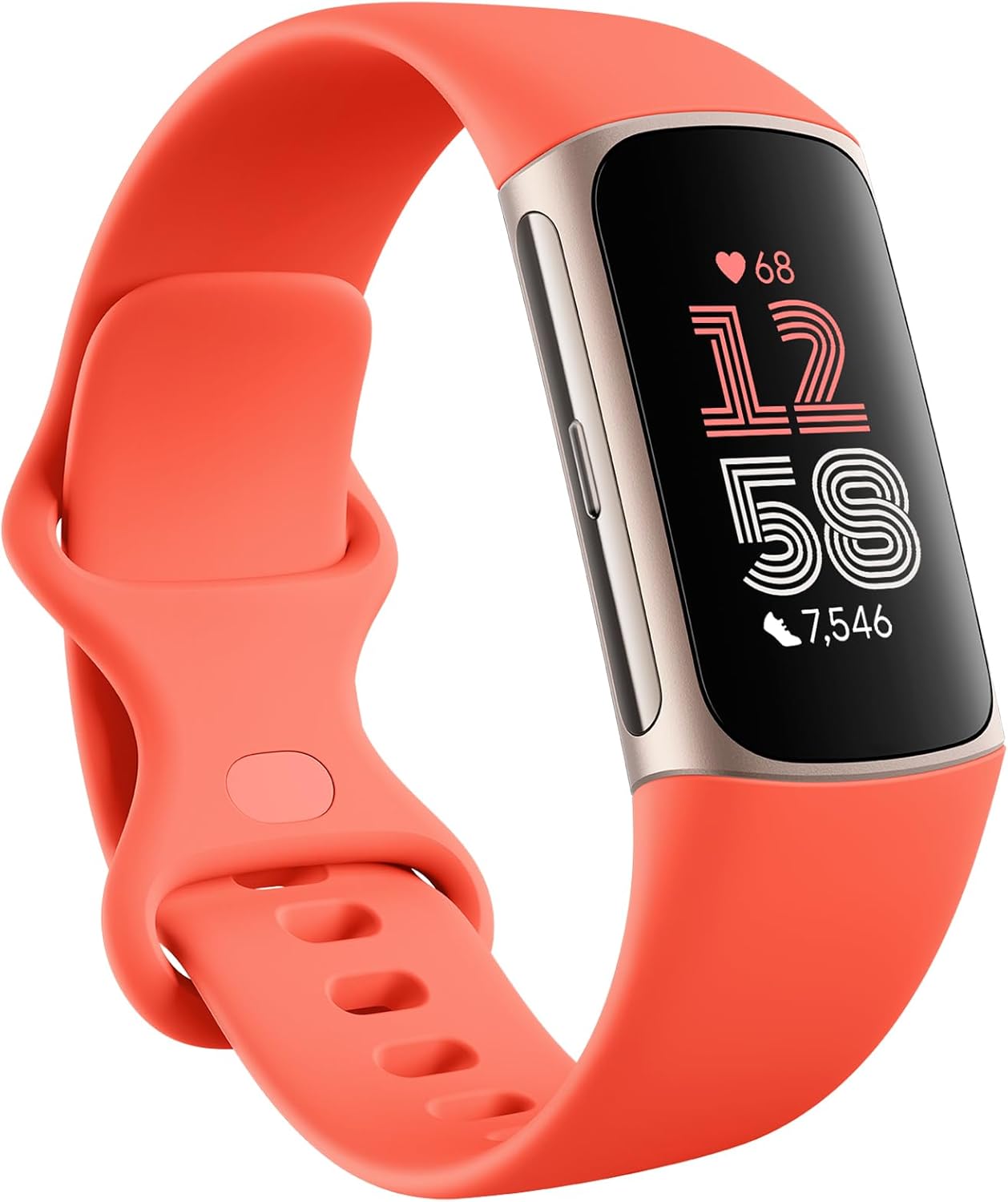 Weight: 1.3 oz.
Weight: 1.3 oz.
Battery: Lithium-polymer (7 days)
Diameter: 36.8mm
What we like: Great combination of fitness and lifestyle features in a simple and user-friendly design.
What we don’t: Limited backcountry appeal; some features require a subscription to access.
Fitbit watches have been a staple of the fitness industry since the early 2000s, and after being acquired by Google in 2021, their game has only improved. The latest update to the brand’s Charge series, the Charge 6 packs a surprisingly strong punch into an affordable and low-profile package. With more than 40 exercise modes (including skiing, hiking, kayaking, and many other outdoor activities), a new and improved heart rate sensor, built-in GPS tracking, Bluetooth connectivity to workout equipment, and general health monitoring, the Charge 6 checks many of the boxes we look for in a daily and workout companion. It also comes equipped with modern features like YouTube music controls, tap to pay via Google Wallet, and on-screen alerts for calls, texts, and app notifications.
There’s a lot to like about this little watch, one of which is, in fact, its diminutive size. However, while some will appreciate the simplified build and shorter learning curve of the basic interface, the Fitbit’s features are decidedly limited compared to the competition. For starters, while the Charge 6 offers GPS tracking, it’s notably less refined than what you get with GPS giant Garmin, and we’ve found it difficult to maintain signal throughout a workout (although you can connect to your phone’s GPS for better accuracy). It also has a middling battery life (just seven days), water resistance (5 ATM), and durability (aluminum housing and simple glass face)—all of which aren’t ideal for frequent outdoor use. Finally, some features can only be accessed with a $10-per-month Fitbit Premium subscription, including your daily readiness score, sleep profile, and wellness report. If these are important to you, the $229 Coros Pace 3 above will be a cheaper option in the long run, although the Charge 6 is much lower-profile and the better value for those who don’t anticipate using all of the features.
See the Fitbit Charge 6
| Watch | Price | Weight | Battery* | Diameter(s) | ABC | Music | Touch |
|---|---|---|---|---|---|---|---|
| Garmin Forerunner 265 | $450 | 1.7 oz. | 13 days | 42, 46mm | Yes | Yes (storage) | Yes |
| Coros Pace 3 | $229 | 1.1 oz. | 17 days | 41.9mm | Yes | Yes (storage) | Yes |
| Garmin Fenix 7 Pro Sapphire | $900 | 2.8 oz. | 18 days | 42, 47mm | Yes | Yes (storage) | Yes |
| Garmin Forerunner 965 | $600 | 1.9 oz. | 23 days | 47.2mm | Yes | Yes (storage) | Yes |
| Garmin vívoactive 5 | $300 | 1.3 oz. | 11 days | 42.2mm | No | Yes (storage) | Yes |
| Garmin Instinct 3 Solar | $400 | 2.8 oz. | 28 days | 40, 45, 50mm | Yes | Yes (control) | No |
| Coros Apex 2 | $349 | 1.5 oz. | 14 days | 43mm | Yes | Yes (storage) | Yes |
| Suunto Race | $399 | 2.9 oz. | 26 days | 49mm | Yes | Yes (control) | Yes |
| Polar Grit X2 Pro | $750 | 2.8 oz. | 10 days | 48.6mm | Yes | Yes (control) | Yes |
| Garmin Lily 2 | $250 | 0.9 oz. | 5 days | 35.4mm | No | Yes (control) | Yes |
| Apple Watch Ultra 2 | $799 | 2.2 oz. | 36 hours | 44mm | Yes | Yes (storage) | Yes |
| Coros Vertix 2S | $699 | 2.5 oz. | 40 days | 50.3mm | Yes | Yes (storage) | Yes |
| Garmin Forerunner 165 | $250 | 1.4 oz. | 11 days | 43mm | No | Yes (control) | Yes |
| Fitbit Charge 6 | $160 | 1.3 oz. | 7 days | 36.8mm | No | Yes (control) | Yes |
*Editor’s note: The stated battery life is the manufacturer’s claim while in time mode. When using workout tracking, smart features, or GPS, battery life will be reduced.
The Switchback Travel staff has tested dozens of fitness watches over the years, from budget-friendly designs with streamlined feature sets to premium, backcountry-ready options with all the bells and whistles. Former senior editor Jenny Abegg compiled our original list of 16 sports watches in 2022 after putting several to the test on mountain scrambles and other fast-and-light alpine objectives in the Pacific Northwest. Nick Mott gave the guide a healthy revamp in 2024, contributing his expertise as a discerning sports watch user both in his day-to-day life and as a trail runner, backpacker, and skier. Editor Maddie Downie now manages the guide. An avid backcountry enthusiast, Maddie loves to geek out on training metrics and feels like a kid in a candy shop when it comes to testing the latest fitness watch technology.
We’ve slowly whittled the list down to 14 picks, which was the result of extensive in-house testing, feedback from our network of techy friends and mountain athletes, and tapping into the online hiking and endurance sport communities. When testing fitness watches, we dig into the nitty gritty by exploring all of the features—from training metrics to sleep tracking—to evaluate their accuracy and ease of use. We also pay close attention to how each watch fares over time, its overall heft and form factor when performing various activities, and how intuitive it is to operate. Finally, we evaluate how long the battery lasts in each mode and download the corresponding app on our smartphone, as functionality can vary widely. As new watches hit the market, we’ll continue testing promising designs and add any that stand out to the list above. And a final note: The options above run the gamut from everyday-friendly to backcountry-ready, but for dedicated outdoor use, check out our list of the best GPS watches.

Activity Tracking and Analysis
One of the primary and most sought-after features of a fitness watch is the ability to track and analyze your activities, whether you’re hiking, running, biking, swimming, skiing, and more. Within each mode, a watch will record your GPS track by collecting waypoints at a set interval (usually every second, or less in battery-saving modes), which translates into information such as distance, elevation, pace (current and elapsed), and cadence—and the list goes on. In most cases, you can view this information both during your activity (on your watch) or via an app on your phone once you’re finished.
As a general rule, entry-level watches like the Coros Pace 3 stick to the basics with fairly limited data points meant for sports like running and cycling. Spending more gets you greater access to information for a wider range of activities (high-end designs have dozens of sport modes, including paddle boarding, golfing, and indoor climbing). And interestingly, accuracy is pretty similar across the board. For example, the budget Coros Pace 3 is known to provide equally reliable GPS tracking data (like distance and pace) as a watch like the Garmin Fenix 7 Pro, which costs around three times as much.
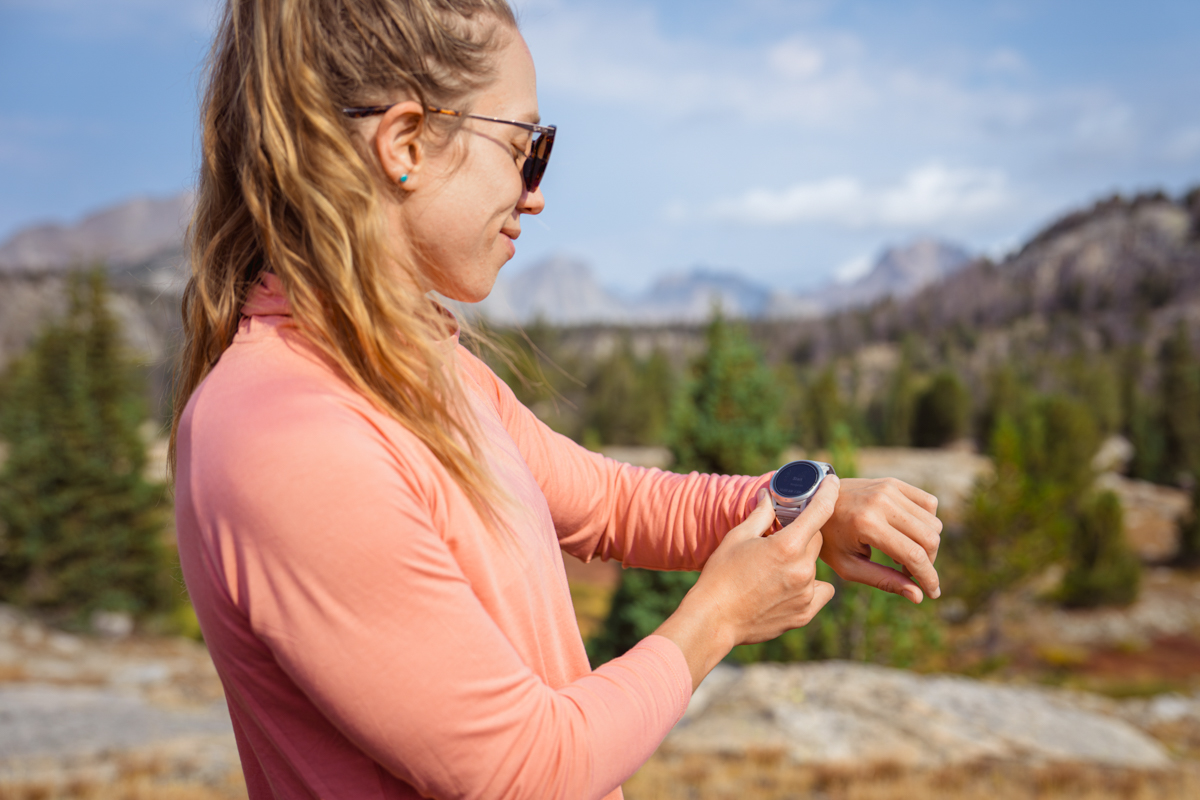
Along with tracking activities, many athletes use their fitness watch to collect body-related data to aid in training. A watch is a rather impressive tool in this regard—it’s able to synthesize data gathered by the optical heart rate monitor and pulse oximeter (usually only available in premium designs) and combine it with activity tracking stats to provide information such as training load, training effect, altitude acclimation, sleep quality, and more. These measurements will help you know how hard you worked, how much recovery time you need, and what to aim for during your next workout. Further, a good number of watches now feature training plans for a variety of activities, providing alerts and audio prompts based on your pace, heart rate, functional threshold power (biking), and more. The Garmin Fenix 7 Pro even provides animated pilates, yoga, cardio, and strength workouts on its high-resolution screen. If you want to use your watch as a personal trainer, look for a high-end model that includes a pulse oximeter and prioritizes multisport features (Garmin watches excel here).
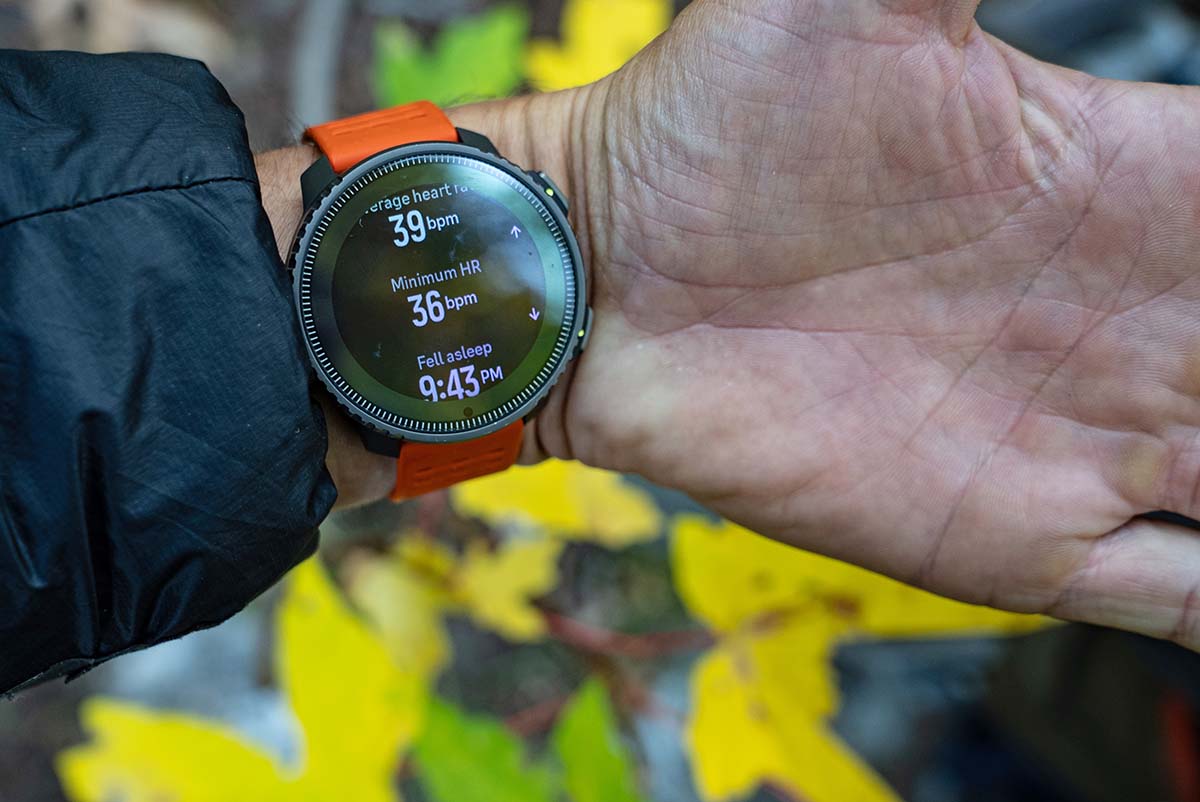
Maps and Navigation
Many (but not all) of the watches here include some navigational features. Like a standard GPS device, these watches allow you to upload and follow .gpx tracks (also known as breadcrumb navigation), pinpoint your location on a preloaded map or track, record your route in order to retrace your steps, and even view your surroundings. With the most basic navigation, you’ll see a simple line with a waypoint marker on an otherwise blank screen, while the most premium outdoor watches feature preloaded color topographic maps with detailed contour lines, geographic place names, and more. Models like the Garmin Forerunner 965 even include maps for over 2,000 ski resorts and 42,000 golf courses.

Most users will find their watches’ navigational features helpful for following a preset route or retracing their steps on a breadcrumb trail. Many watches use alerts to tell you when you’ve gotten off track (this is super helpful and limits how often you need to look at your watch), and you can also use the “back to start” feature to navigate back to your original starting point. More advanced users will appreciate the detailed topographic mapping of premium watches, which provides helpful insights into the terrain, including expected elevation change if you’re off-trail or considering a different route. If you plan to use your watch for complex backcountry navigation (i.e., in lieu of a GPS device or smartphone with mapping app), we recommend looking for premium mapping tech like that of the Fenix 7 Pro or Forerunner 965. If you commonly travel with another device or don’t intend to venture too far into the backcountry, you can get away with more basic navigational tools—like the Google Maps functionality you get with the Fitbit Charge 6.
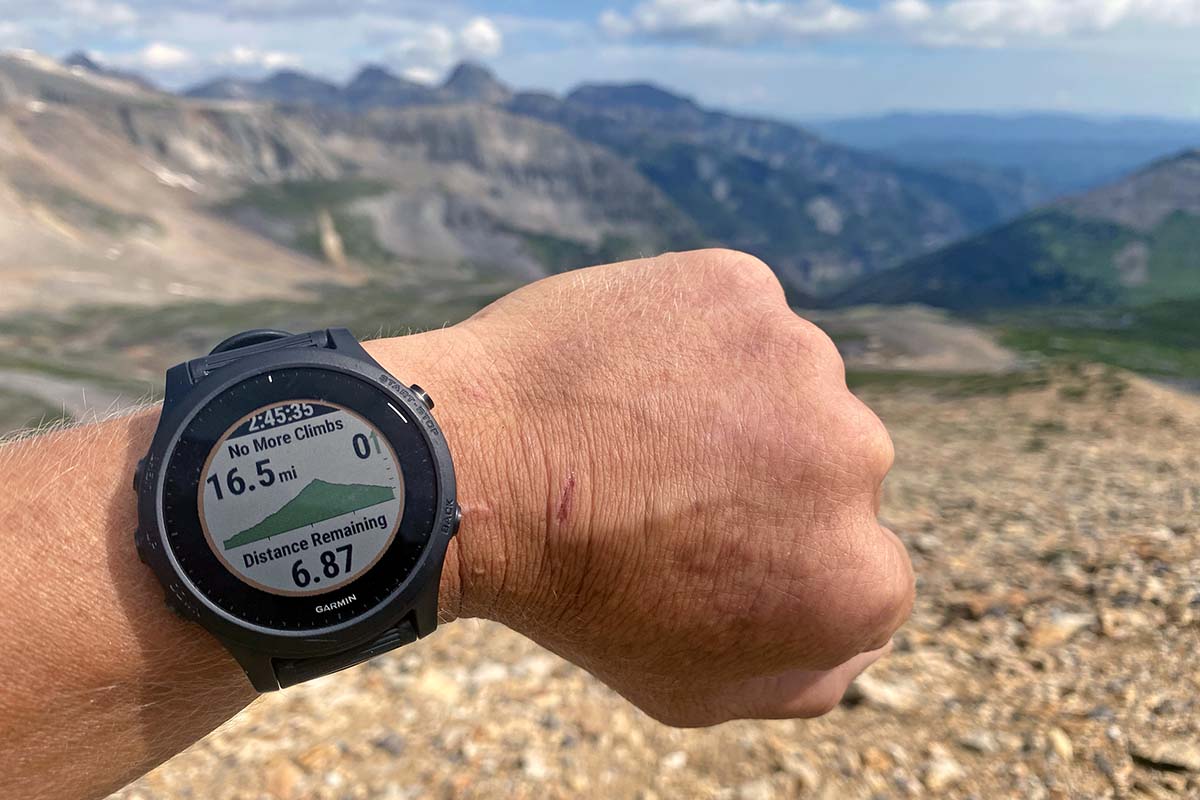
Weather Forecasting
In the past, one of the primary features of an outdoor watch (often referred to as an altimeter watch) was its ability to predict weather through changes in air pressure. This capability is still present in most modern smartwatches and uses the same age-old technology of a barometric altimeter. The Coros Vertix 2S, for example, provides a weather forecast based on the most recent six hours of air pressure and includes a storm alert feature when it senses a drastic change. In addition to air pressure, many watches are able to measure ambient air temperature (we find this feature works best when you remove the watch from your wrist) and can determine sunrise and sunset based on your GPS location. If you’re headed to the mountains and want a watch with weather forecasting capabilities, make sure you select one with a barometric altimeter (most models here—but not all—have this feature).
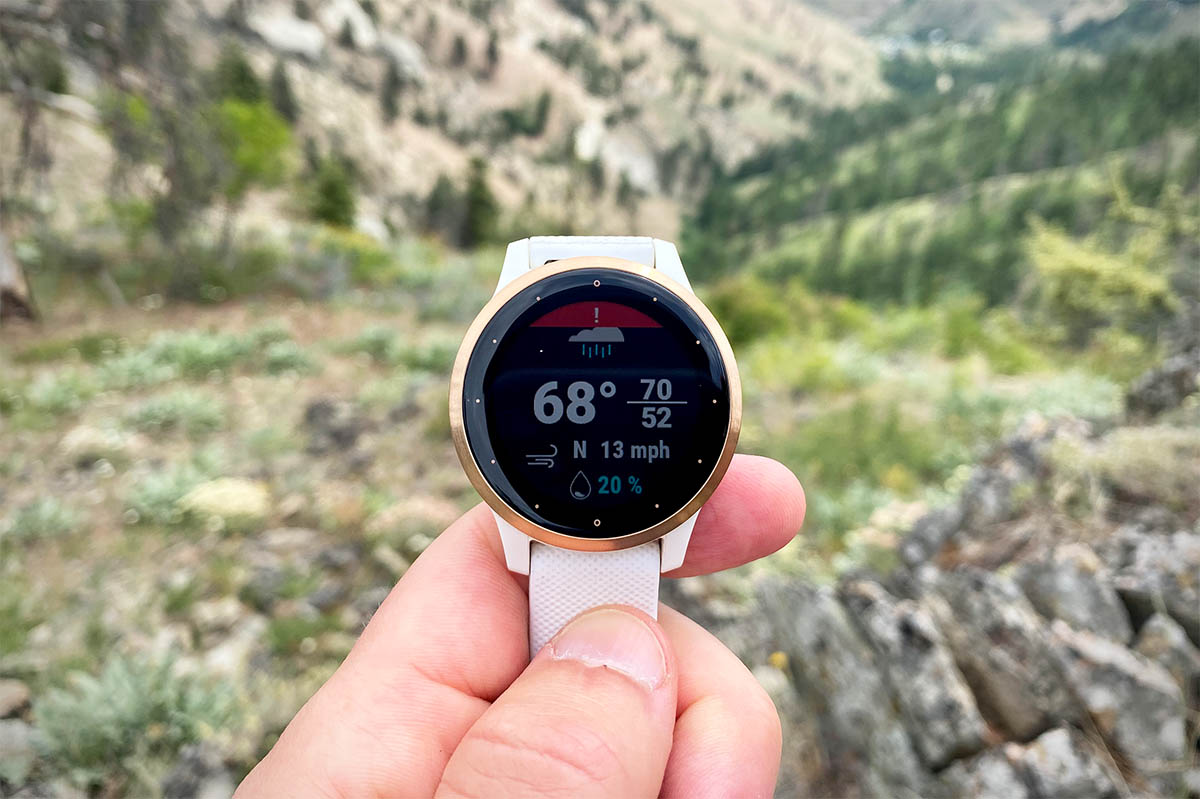
Health Monitoring
With built-in heart rate monitors and pulse oximeters, modern fitness watches are able to provide users with a wealth of health data. By combining data from your workouts with stats like heart rate (active and resting) and blood oxygen saturation, you can have access to some very in-depth information, including respiration rate, sleep quality, energy and stress levels, recovery time, and more. The most premium watches can even track your hydration and offer insights for women regarding their menstrual cycles (Garmin's Lily 2 offers in-depth cycle data). Your watch’s app is integral to its health monitoring ecosystem, with helpful alerts, extra data points, and detailed graphs that allow you to track your stats over a given time frame. Garmin and Apple are clear leaders in this department (the Apple Watch Ultra 2 even includes an electrocardiogram), while Coros’ offerings fall notably short—their interface lacks the synthesis we see from more premium brands, sticking to the basics like exercise time, steps, heart rate, and VO2 max.
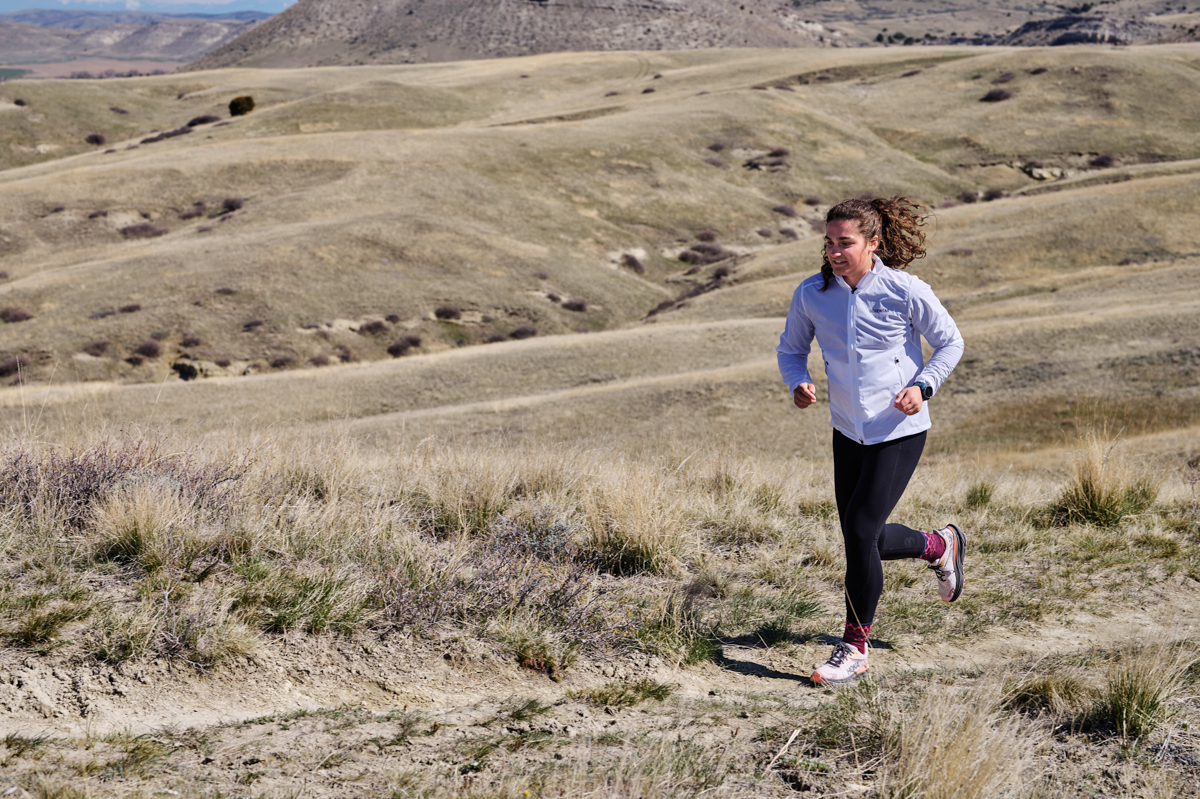
Smart Features
Fitness watches are essentially miniature computers, and most can connect to your smartphone via bluetooth. This capability allows you to treat your watch like a mini phone, receiving texts, rejecting and responding to phone calls with an automatic text, purchasing goods via contactless pay, accessing your calendar, and more. One of the most sought-after smart features on a fitness watch is the ability to play or control music: Some watches can store songs (the Garmin Forerunner 965 fits up to 2,000) so you can work out without your phone, while others allow you to control music playing from your phone. Many of today’s watches also have the option for virtual coaching or preloaded workouts (including yoga, pilates, and more). High-end watches from Garmin (and of course Apple) tend to excel in smart features, while entry-level models feature only the bare minimum (no music or contactless pay, for example).
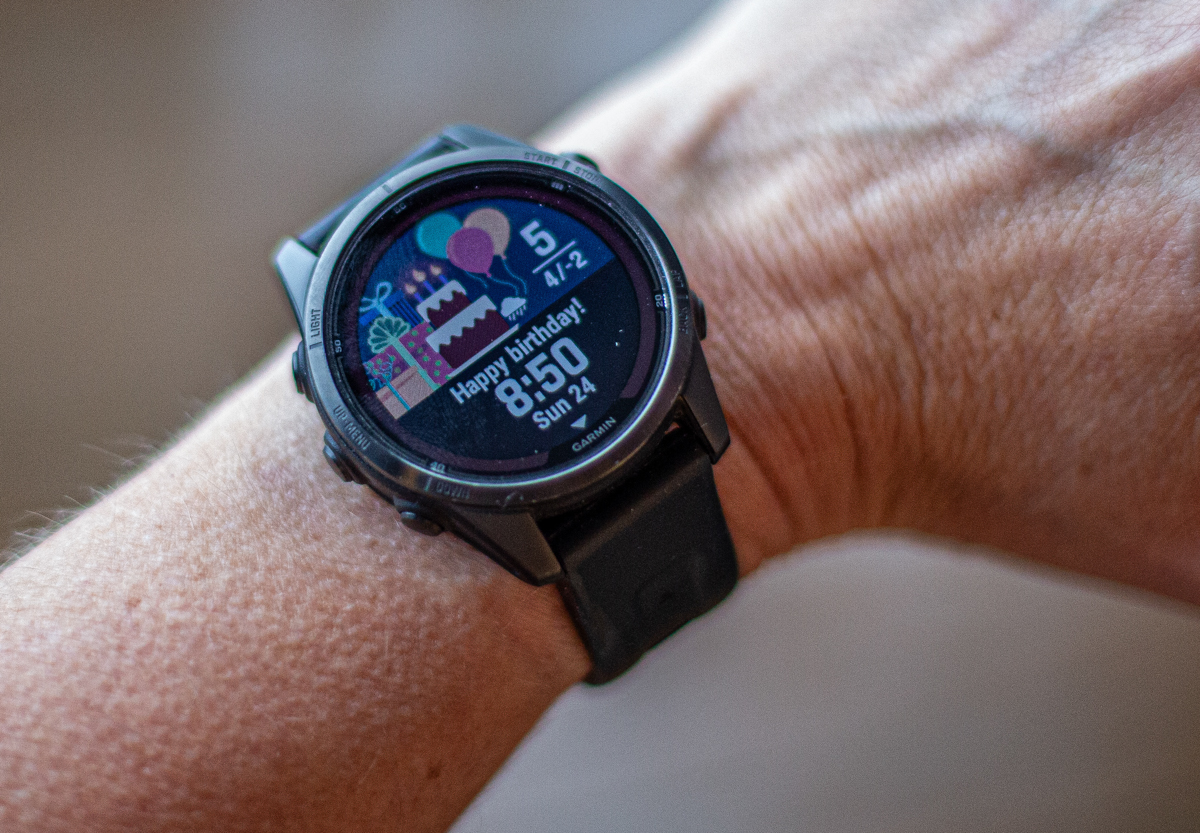
Clock Features
Lest we forget, a fitness watch does offer a host of clock features as well. In terms of telling time, fitness watches are fairly advanced as they’re able to connect with satellites in real time: You get GPS time sync (helpful when you’re out of service), automatic adjustment for daylight saving time, and the ability to determine sunrise and sunset. You’ll also find common features such as a timer (many have interval timers), stopwatch, alarm clock, and more.
GPS and Multi-GNSS Support
Fitness watches have undergone a massive evolution in the last decade or so, and the vast majority (and every model above except the Garmin Lily 2) are now equipped with GPS. Built-in GPS allows a watch to determine your location at any moment in time, which has virtually endless applications in terms of activity tracking, navigation and mapping, data collection, and more. Whether you use your watch to log mileage and elevation gain, want to pinpoint your location on a map, or get from point A to point B, you’re putting GPS to work. Note: We've written a separate guide on the best GPS watches, which features a more outdoor-focused lineup than the varied list above.
While almost every watch here connects to the United States’ 31 GPS satellites, many premium designs use additional networks as well, including Russia’s GLONASS, the European Union’s Galileo, and China’s BeiDou. The ability to connect to more satellites is often referred to as multi-GNSS (Global Navigation Satellite System) support and translates to better accuracy and availability. Most users can get away with standard GPS, but those traveling in remote areas or under heavy cover will appreciate the better connectivity of watches equipped with multi-GNSS.

It’s also worth mentioning multi-band GNSS here (also known as dual-frequency GPS), as it’s become a staple of GPS technology in the past few years. Watches with multi-band GNSS not only connect to multiple networks, but they are able to use two different frequencies to connect to each network. The result is a quicker connection and even greater position accuracy, especially in areas lacking a clear view of the sky (like tall buildings, canyons, or trees). We’ve found this video from Garmin to be particularly helpful in understanding multi-band GNSS.
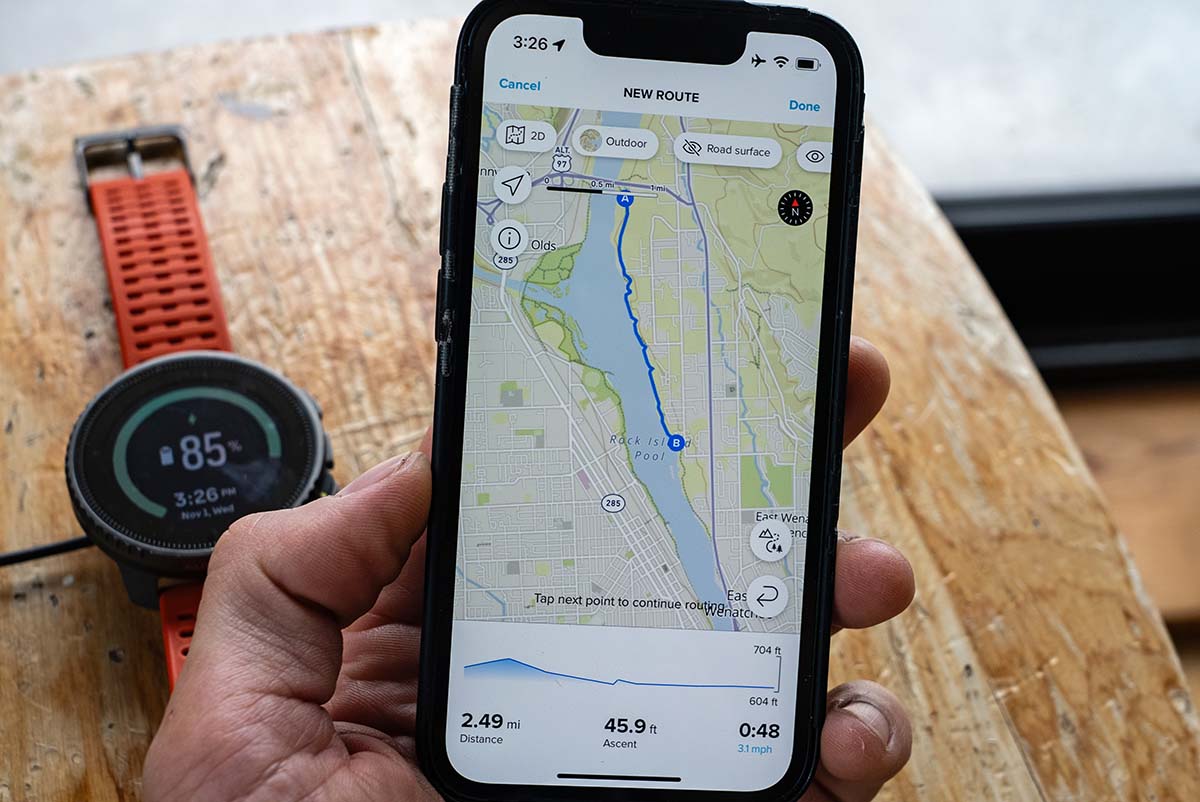
Barometric Altimeter and Compass
The majority of fitness watches also come with a built-in barometric altimeter and compass, commonly referred to as ABC (altimeter, barometer, and compass). The altimeter and barometer (working together, these are often referred to as the barometric altimeter) provide a measurement of air pressure, which is helpful both for predicting weather changes and providing accurate altitude information and ascent/descent data. A compass further aids in location accuracy and navigation and is especially helpful when you’re at rest or moving slowly (GPS struggles in these cases). Combined with GPS, a watch’s barometric altimeter and compass can piece together the most accurate data, and it’s something most performance-oriented users won’t want to go without—just make sure to calibrate these sensors every so often.

Pulse Oximeter and Heart Rate Monitor
Most watches have an optical heart rate monitor, and a number of premium designs also include a pulse oximeter (also known as a blood oxygen sensor). Optical heart rate monitors measure the speed of your blood flow (i.e., your pulse) by shining a light through your skin and provide a wealth of data regarding resting heart rate, fatigue and recovery, aerobic versus anaerobic state, and more. A pulse oximeter sensor, on the other hand, looks at the color of your blood to measure its oxygen saturation (SpO2) as a percentage—a healthy number is about 95 to 100%—which can be helpful for those with health issues or athletes pushing their limits in terms of cardio or altitude.
You can expect high-end watches to have the most accurate sensors, but the truth is that no watch-based pulse oximeter or heart rate monitor is entirely reliable. In fact, companies like Garmin and Apple clearly state that their sensors are not intended for medical use, as they can easily be thrown off by minor details like how tightly you wear your watch, where you place it along your wrist, or inconsistencies like hair or freckles (Suunto has a helpful guide on how to get the most accurate reading). If you have a particular need for accurate blood oxygen saturation or heart rate numbers, it’s a good idea to opt for a dedicated pulse oximeter (these generally attach to your finger) or chest strap instead.
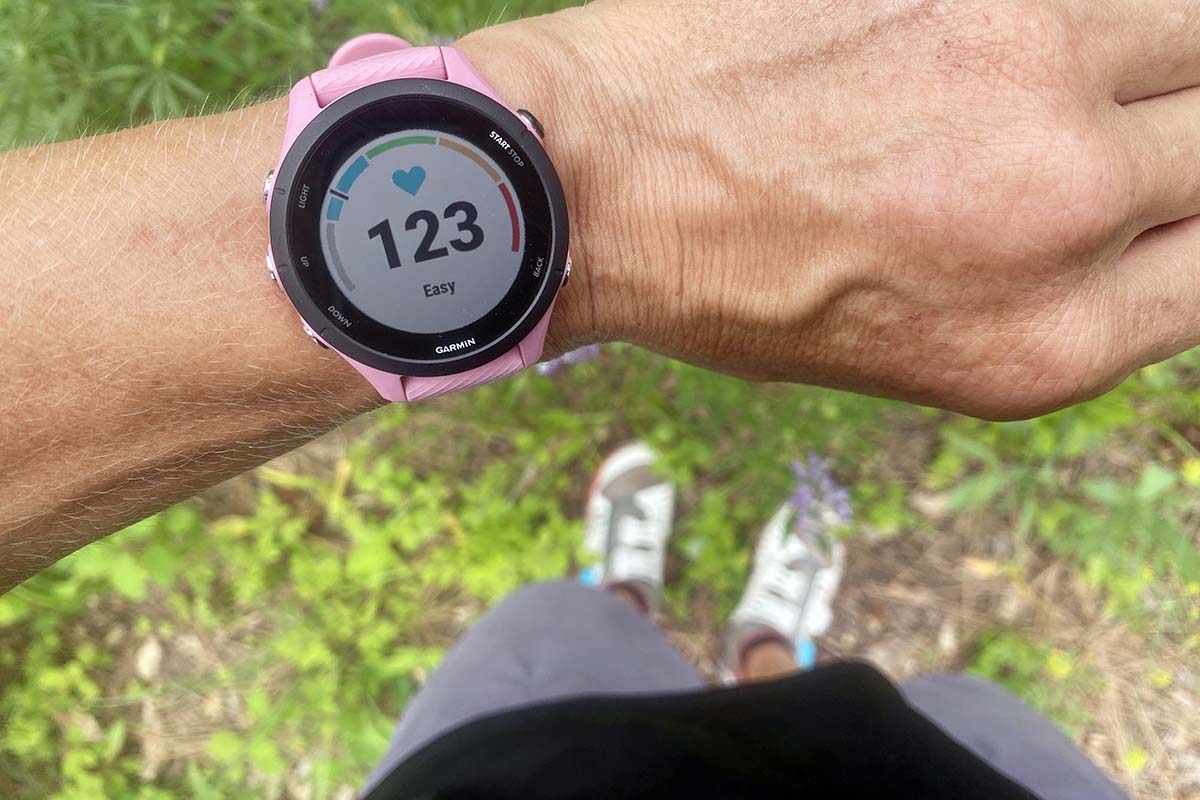
Other Sensors
In addition to those mentioned above, there are a few other sensors to have on your radar. Most sports watches will include an accelerometer and gyroscope, which help to measure speed, whether you’re moving forward or backward, your body’s orientation (upright, seated, lying down), step count, and more. Thermometers are also common and can measure both skin temperature (helpful for health data and menstrual cycle tracking) and ambient air temperature. And the list goes on, including skin conductance sensors, proximity sensors, brightness sensors, and more. In general, the more sensors on the watch, the more accurate your data will be. You can also purchase additional sensors separately, like the running-specific Stryd power meter or a bike cadence sensor, and pair them with your watch for even more data collection.
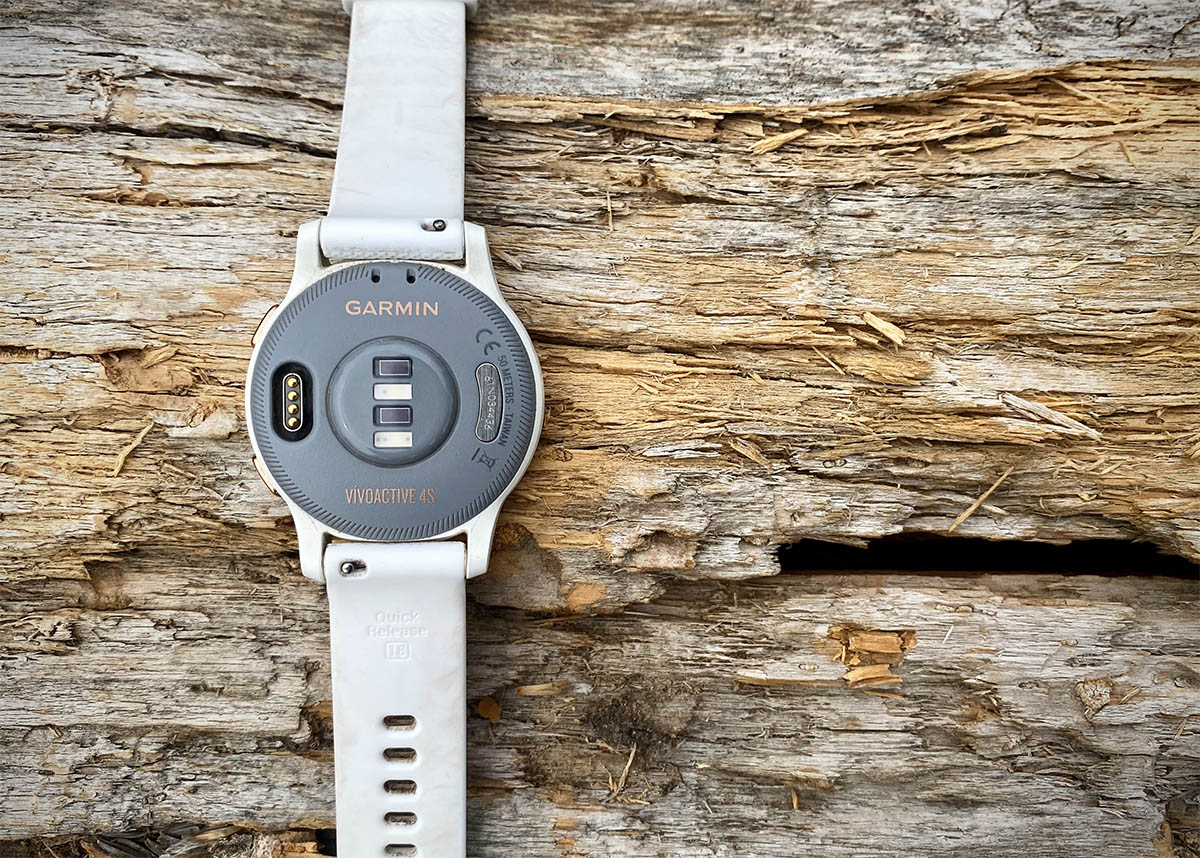
Like a smartphone, most GPS-enabled watches rely on rechargeable lithium batteries. These batteries charge quickly (the Garmin Forerunner 265 refuels in just 2 hours), and their lifespan seems to improve with just about every new release. Using the Garmin Fenix as an example, the old 5X maxed out at 20 hours in GPS mode, while the latest 8 Pro has jumped to 67 hours. In addition, most watches offer various battery-saving modes: You can shut down sensors (such as GPS or the pulse oximeter) for a longer lifespan (up to 40-50 days for some watches) or use “expedition mode” to cut down on how often the watch tracks your location (keep in mind, this will affect recording accuracy). While not every user will prioritize battery life in their purchase, this is an important consideration for those logging long days (e.g., ultramarathoners) or tracking extended backcountry trips (the Coros Apex 2 is one of the best performers).
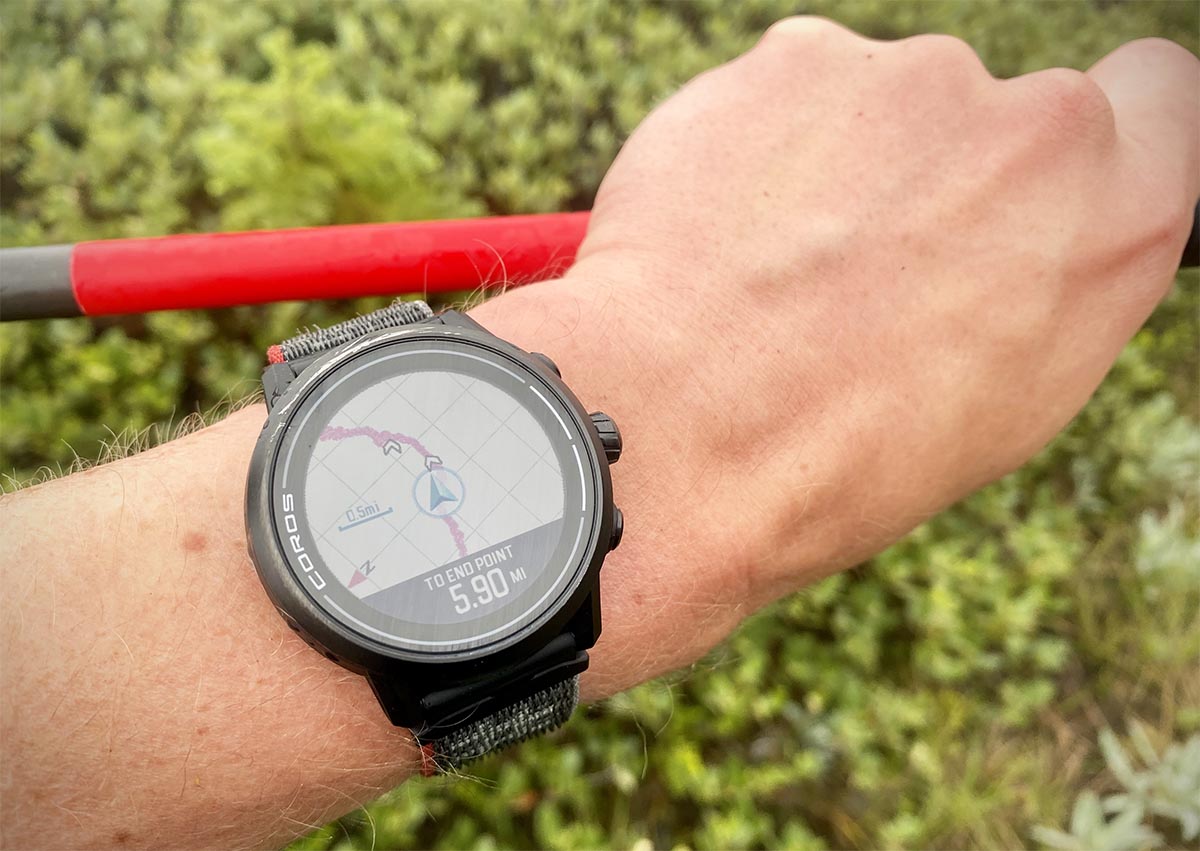
Some fitness watches also come with built-in solar panels, which can go a long way towards keeping your watch running. Garmin’s Instinct 3 Solar is among our favorites in this category, featuring a lifespan of up to 40 hours in GPS mode and unlimited power in expedition mode. Of course, a watch’s ability to charge via the sun does depend on the intensity and duration of the rays, which makes a solar watch a great pick for sunny desert environments but not the best choice for socked-in mountain landscapes. But the good news is that you can always fall back on the lithium ion battery, which can be quickly and easily charged via a power bank in the field.
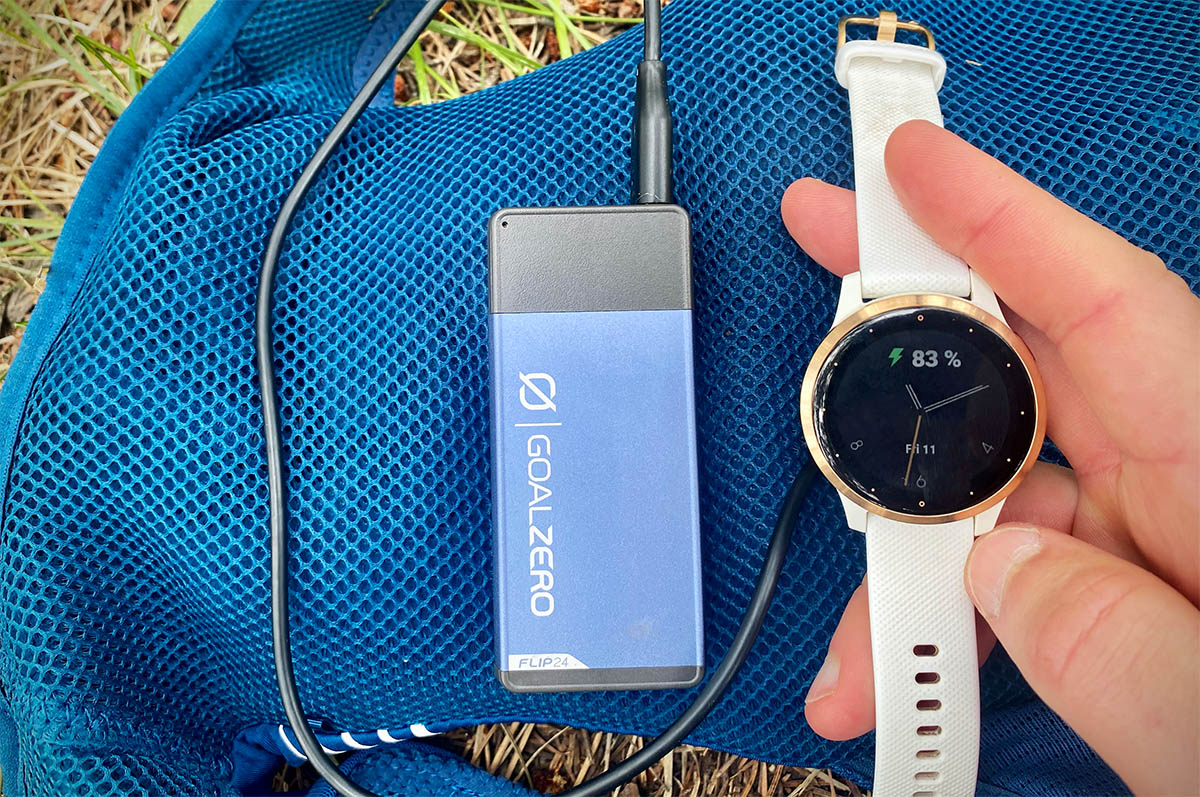
We see a lot of variation in terms of the type of materials used to build a watch, including the lens, bezel, case, and strap. A watch’s materials have a number of implications, including fit and finish (how “premium” the watch feels), durability and water resistance, weight and size, price and more. In general, the most durable and high-end watches here will feature sapphire crystal or Gorilla Glass lenses, stainless steel, carbon, or titanium bezels (rugged watches like the Garmin Instinct might also feature a polymer bezel), and silicone straps. These watches are incredibly scratch- and shatter-resistant and can take a true beating, but you’ll pay for it with heavier and bulkier builds and big price tags.

On the other hand, mid-range and entry-level watches like the Coros Pace 3 feature standard mineral glass (or even polyamide) lenses and more plastic throughout. A watch’s materials are also a great way to determine what it’s made for: Durable materials indicate a watch that will withstand the rigors of hiking, mountaineering, and climbing, while less durable (but potentially lighter) materials are best for activities like road running, cycling, and strength training.

It’s also worth understanding your watch’s level of water resistance, which is directly tied to its standard of materials and construction. Most manufactures list an ATM rating for their products, which, in the case of the picks above, ranges from 5 to 10 and specifies how much water pressure a watch can withstand. A watch with a 5 ATM rating, for example, can handle pressure up to a depth of 50 meters, while a watch with a 10 ATM rating can handle pressure up to 100 meters in depth. Keep in mind that this number indicates pressure, not depth—for example, showering or certain swimming motions can replicate the amount of pressure you might experience 50 meters beneath the surface. If you plan to swim with your watch, we recommend a model with a rating of 10 ATM or above, and divers should opt for dive-specific models like the Garmin Descent (not included here). That said, for the standard user (including swimmers), any watch above is sufficiently water-resistant.
Since you’ll be wearing it for extended periods, the physical size and heft of a sports watch is an important consideration. Above, we provide details on each watch’s diameter and weight (including the strap), and manufacturers will often list the height of the watch as well. Many of the more backcountry-ready models here—like the Garmin Fenix 7 Pro—take up quite a bit of real estate and can be uncomfortable for active pursuits such as running, XC skiing, or swimming. The good news is that there are a number of trimmed-down models, including the 1.1-ounce Coros Pace 3 and smaller Garmin Forerunner 265S (both 42mm), as well as Fitbit's truly low-profile Charge 6. You do sacrifice a little screen size, durability, and often some battery life in going with the smaller and lighter variations, but the trade-off in comfort will be well worth it for some.
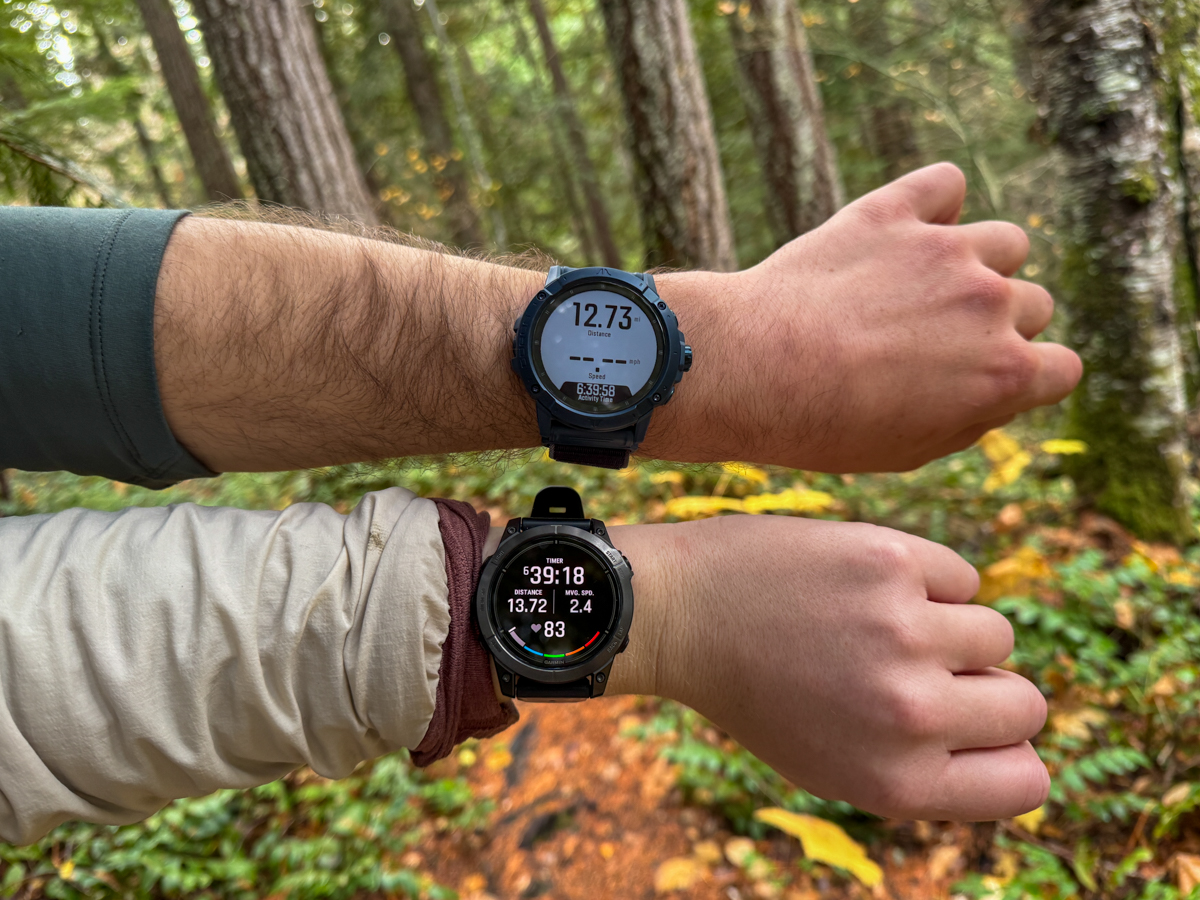
A fitness watch’s display is another important consideration. These range in terms of size and resolution, and you’ll find both monochrome and color versions in the list of picks above. For example, the premium Instinct 3 Solar has a 1.2-inch diameter and 390 x 390-pixel resolution color display, while the simplistic Coros Pace 3 has a similar display size but only a 240 x 240-pixel resolution. On the far end of the spectrum are brilliant AMOLED displays, most common in the smartwatch world and epitomized by the clear and colorful Apple Watch Ultra 2. Garmin also recently hopped on the AMOLED bandwagon with its updated Forerunner, Fenix, Instinct, and Epix collections. For the most part, you can expect the most high-end watches to include large, high-resolution, and colorful displays, which can be especially helpful if you’re doing a lot of wrist-based navigation or plan to look at your watch a lot throughout the day. If you use your watch simply to collect data to then assimilate on your phone or computer, you can get away with a smaller or lower-quality display.
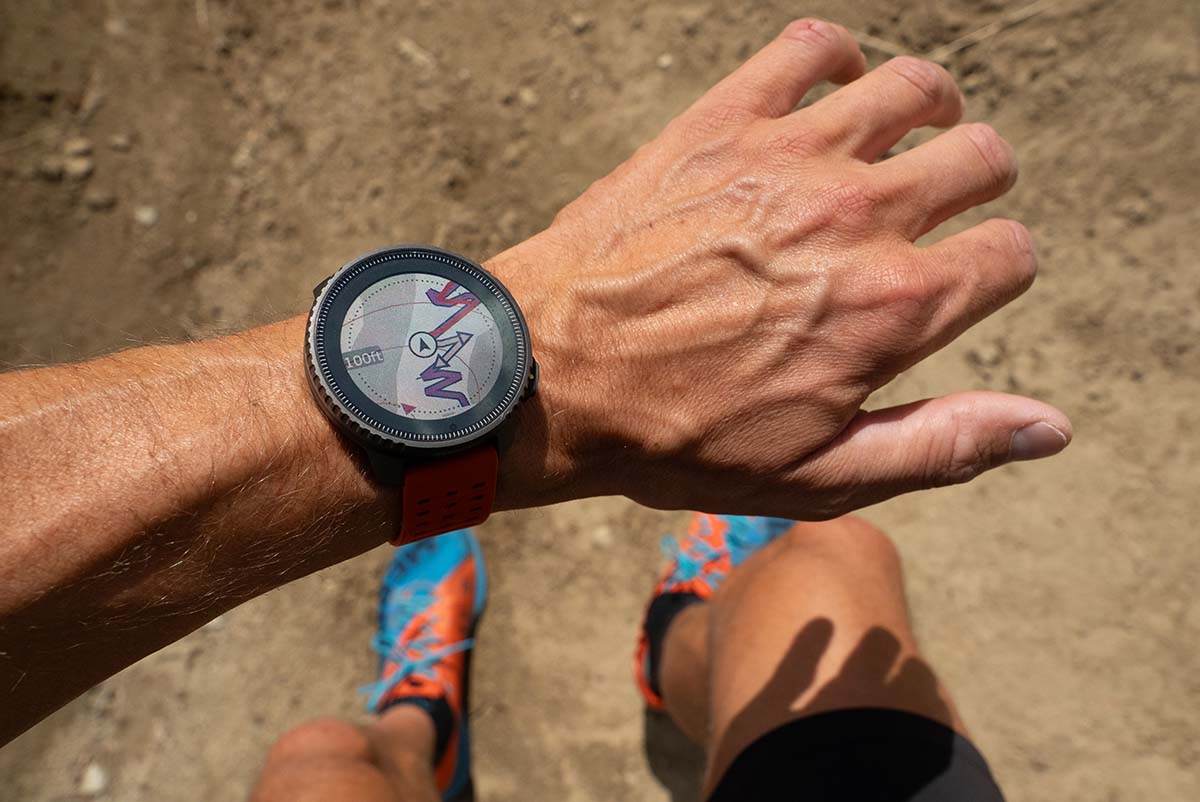
Depending on the make and model, there are a variety of ways to toggle settings and switch between modes on a fitness watch, including side buttons and dials and even touchscreen functionality. Feature-rich designs like the Fenix 7 Pro have five buttons, while midrange watches from Coros feature just two dials/buttons (some casual, stylish offerings, like the Garmin Lily 2, have none). In the end, the choice will come down to personal preference. For example, we love the simplicity of our Coros Apex 2, but Garmin devotees will likely want to stick with the Garmin interface, and there’s bound to be a learning curve no matter what you choose. For outdoor use, we tend to stay away from touchscreens, as water can interfere with this technology and make it hard to swipe precisely while in motion (buttons are much better for that). Plus, we like the versatility of being able to operate our watch with gloves on. That said, if you’re planning to use your watch for a lot of navigation or simply like the tech for daily use, the touchscreen capability can be nice.
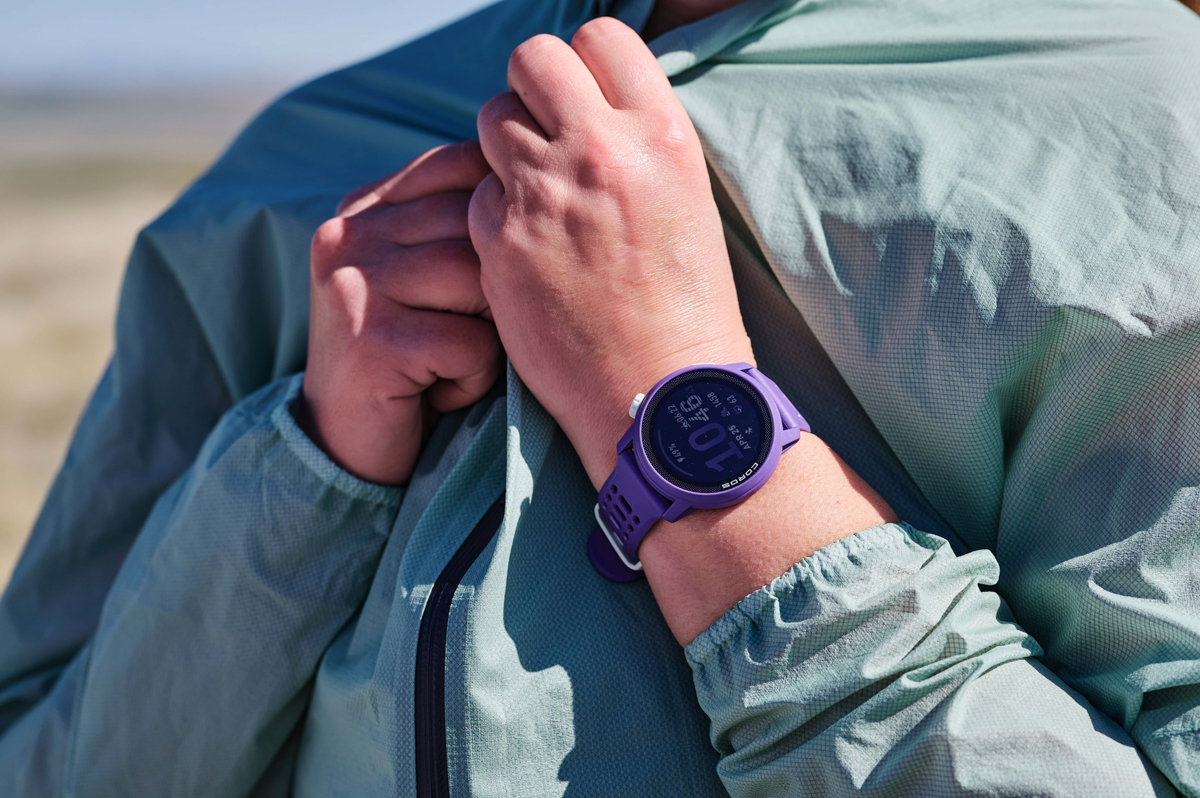
One of the most used features of a fitness watch is not actually the watch itself, but its corresponding smartphone app. Here’s how it works: A user records their activity with their watch, uploads the data and track to their phone via bluetooth, and is then able to access easy-to-digest charts, maps, tracks, comparison tables, health details, and more on the phone’s screen. Apps can also be helpful during the activity, whether you’re wanting to share live tracks from the field or follow a prescribed workout. And the list goes on: You can export your data to your favorite training app (think Strava and TrainingPeaks), transfer music (via Spotify and Apple Music, for example), and even get motivated by suggestions and training plans smartly engineered based on your stats.
Garmin has long been an industry leader in terms of app functionality and performed head and shoulders above the rest throughout our testing. First off, they have an entire app (Connect IQ) dedicated to customizing the watch, including downloading watch faces, tweaking settings, and syncing apps like Spotify and Trailforks. Their interface is also accessible both on your smartphone and via an internet browser on your desktop (Coros’ is limited to the app), which gives you even more versatility. And to add to their dominance, Garmin has successfully created an active online community, where you can follow friends, select challenges, and share your results. And a last note: Before you buy, make sure your phone and watch are compatible. For example, Garmin watches can only be paired with phones that use an Apple or Android operating system.
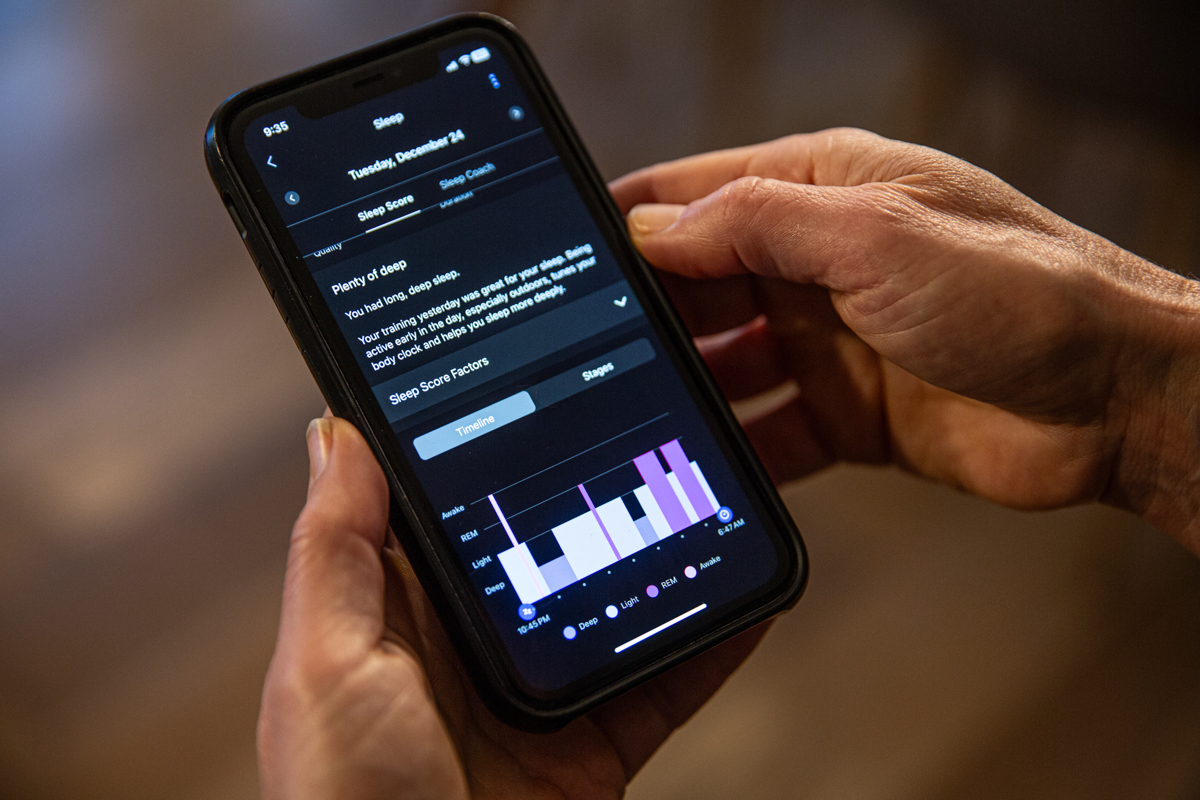
While not everyone will need to pay attention to storage and memory, these are important numbers if you’re looking to get a lot out of your watch. With more capacity, you can record multiple tracks between syncs, upload maps and tracks, and store hours of songs and podcasts. The Garmin Fenix 7 Pro, for example, comes with 16 gigabytes of memory that can handle up to 2,000 songs and thousands of maps and GPS routes. But if you’re syncing your watch with your phone after each activity, it’s likely you don’t need to worry about storage.
As we see with smartphones, manufacturers will periodically roll out firmware updates for their watches. These updates can range from simple bug fixes to full revamps—for example, one of Coros' latest updates available for all of their models included features like a track run setting, more precise time metrics (up to 0.01 seconds), and new map layer options. We really love this part of fitness watch design, as it means that you can essentially stay up-to-date on the latest features without having to buy a new watch. To update your firmware, simply connect your watch to your phone’s app, and the download will start via bluetooth.
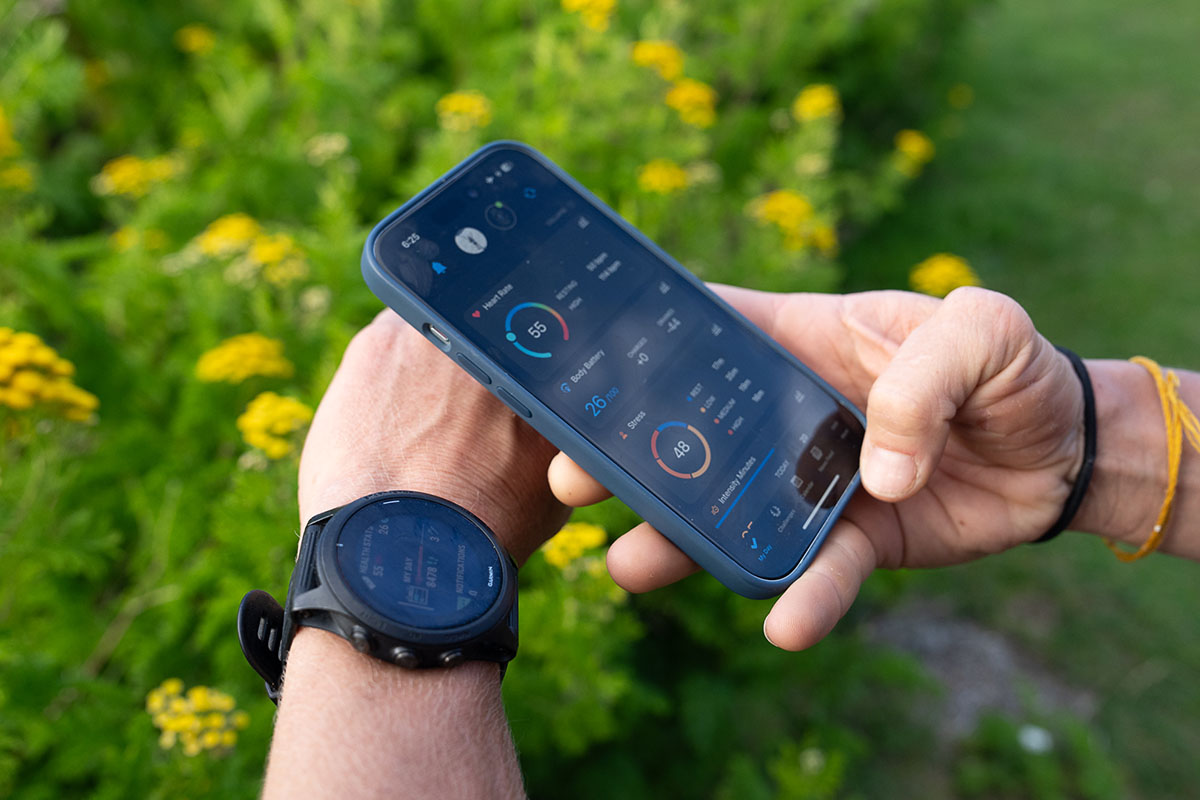
Fitness watches are incredibly capable devices, but if you’re serious about activity tracking, you’ll probably want to tack on an accessory or two during your workout. Chest heart rate monitors are one of the most popular external sensors—these provide more accurate data than even the highest-end optical heart rate monitor. Runners will also want to consider a footpod or power meter, which collect standard metrics like pace and distance, along with running dynamics like stride length, vertical oscillation, and ground contact time (and even fatigue and wind). If you plan to use additional sensors, it’s a good idea to confirm that a watch is compatible before purchasing (most here are). Further, most watches can be used with accessories from other brands—for instance, Garmin designs pair easily with the Stryd footpod.
Back to Our Top Fitness Watch Picks Back to Our Fitness Watch Comparison Table